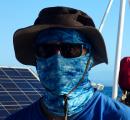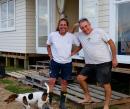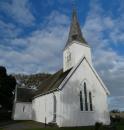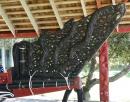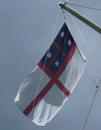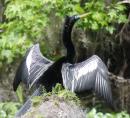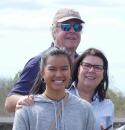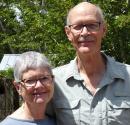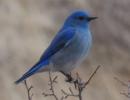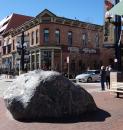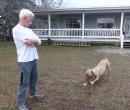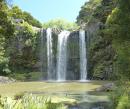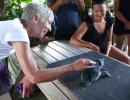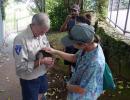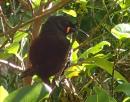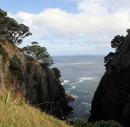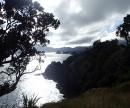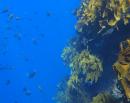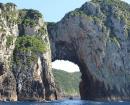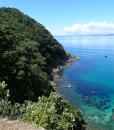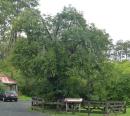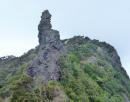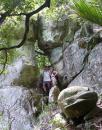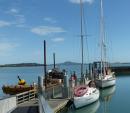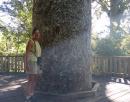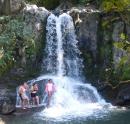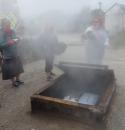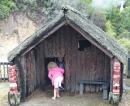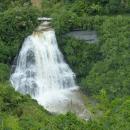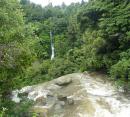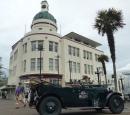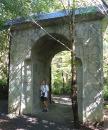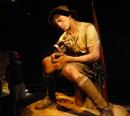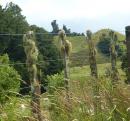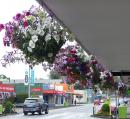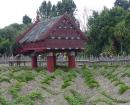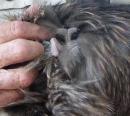
Tregoning
11 March 2020 | Prince of Wales Bay Marina, Hobart, Tasmania Australia
02 March 2020 | Duck Pond, Barnes Bay, North Bruny Island, Tasmania, Australia
22 February 2020 | Prince of Wales Bay Marina, Hobart, Tasmania Australia
15 February 2020 | Prince of Wales Bay Marina, Hobart, Tasmania Australia
13 February 2020 | Prince of Wales Bay Marina, Hobart, Tasmania Australia
11 February 2020 | Prince of Wales Bay Marina, Hobart, Tasmania Australia
05 February 2020 | Prince of Wales Bay Marina, Hobart, Tasmania Australia
02 February 2020 | Geilston Bay, off Derwent River, Hobart, Tasmania Australia
30 January 2020 | Dru Point, North West Bay, North of Bruny Island, Tasmania Australia
28 January 2020 | Carnarvon Bay, Near Port Arthur, Tasmania, Australia
25 January 2020 | Anchored near docks in Snug Cove, Eden, NSW, Australia
24 January 2020 | Anchored near docks in Snug Cove, Eden, NSW, Australia
19 January 2020 | East Boyd Bay, near Eden, NSW, Australia
16 January 2020 | Off Cocora Beach, Snug Cove, Eden, NSW, Australia
12 January 2020 | Rozelle/Blackwattle Bays, Sydney, NSW, Australia
05 January 2020 | Sugarloaf Bay, Middle Harbour, Sydney, NSW, Australia
01 January 2020 | Farm Cove, Sydney Harbour, NSW Australia
29 December 2019 | Mooring at Cammeray Marina, Middle Harbour, Sydney, NSW, Australia
20 December 2019 | Tregoning is on a private mooring, Wanda Beach, Port Stephens, NSW, Australia while we fly to NZ
18 December 2019 | Private mooring, Wanda Beach, Port Stephens, NSW, Australia
US to Japan to Türkiye update
12 April 2024 | We are back aboard Tregoning in Mersin Marina, Mersin, Türkiye
Alison Stocker | Photo- Cherry blossoms of varying shades at Sanzen-In Temple, Ohara - Kyoto, Japan
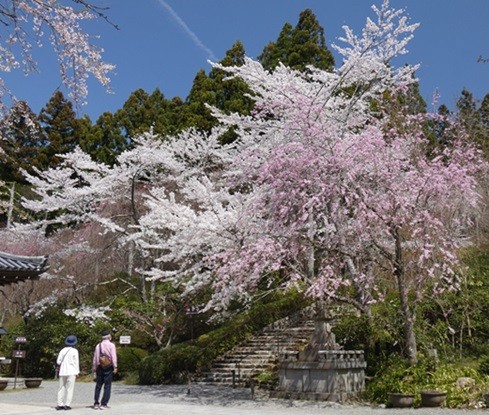
Phew! We are back aboard Tregoning after a fabulous trip to Japan visiting Kaoru and Joe. We crammed so much into six days that it will take me a while to untangle it all and write coherently about it for the blog. So, this is just an update to say that our travels went fairly well…other than such chaos in the Immigration Hall in Tokyo that we missed our connecting flight and then the last bus from Osaka to Kyoto. But a night in a hotel after our series of 3-, 13-, and 1-hour flights was not a bad thing. It stole a night from the company of Kaoru and Joe but we would not have been fit for much anyway.
Initial forecasts were that prime cherry blossoms in Kyoto would be over by the time we arrived, so Kaoru had booked us a night in the mountains where flowering would be a little later. A cold March delayed the opening of the blossoms such that we hit the absolute peak in Kyoto, and it truly was a sight to behold. There were many beautiful trees in isolated places and long avenues of them beside roads or waterways. It was hard to stop taking more and more photographs.
As planned, we met with Jennie and her daughters for an afternoon and evening which was great fun. Like us, they were thrilled to have Kaoru’s expertise in ordering a delightful range of dishes from a popular restaurant. Trying authentic Japanese cuisine was quite a theme throughout our visit from an excellent sushi restaurant to an unusual breakfast with raw egg (tried and rejected), tofu, and fish in a traditional-style inn with hot-springs. In addition to visiting many temples and shrines, Kaoru organized tickets for us to attend a dance performance by Kyoto’s geisha and maiko (geisha-in-training)…oh, yes, despite our short stay, we received a marvelous dose of Japanese culture.
Finally, after another 13-hour flight, we were back in Türkiye, and it did not take long to reach Mersin from Istanbul. As expected Tregoning was very dusty and I have spent the last two mornings washing down the decks, Bimini, and cockpit while Randall installed the many new items that we brought with us from the US. Inevitably, there are a few issues that will need to be addressed before we leave the marina, so we have plenty of boat-work to keep us busy for the next few weeks. Despite that, it feels very good to finally unpack our bags and sleep in our own bed. We have had a wonderful time on our flying trip around the world, but we are ready to start sailing again...hopefully very soon.
Initial forecasts were that prime cherry blossoms in Kyoto would be over by the time we arrived, so Kaoru had booked us a night in the mountains where flowering would be a little later. A cold March delayed the opening of the blossoms such that we hit the absolute peak in Kyoto, and it truly was a sight to behold. There were many beautiful trees in isolated places and long avenues of them beside roads or waterways. It was hard to stop taking more and more photographs.
As planned, we met with Jennie and her daughters for an afternoon and evening which was great fun. Like us, they were thrilled to have Kaoru’s expertise in ordering a delightful range of dishes from a popular restaurant. Trying authentic Japanese cuisine was quite a theme throughout our visit from an excellent sushi restaurant to an unusual breakfast with raw egg (tried and rejected), tofu, and fish in a traditional-style inn with hot-springs. In addition to visiting many temples and shrines, Kaoru organized tickets for us to attend a dance performance by Kyoto’s geisha and maiko (geisha-in-training)…oh, yes, despite our short stay, we received a marvelous dose of Japanese culture.
Finally, after another 13-hour flight, we were back in Türkiye, and it did not take long to reach Mersin from Istanbul. As expected Tregoning was very dusty and I have spent the last two mornings washing down the decks, Bimini, and cockpit while Randall installed the many new items that we brought with us from the US. Inevitably, there are a few issues that will need to be addressed before we leave the marina, so we have plenty of boat-work to keep us busy for the next few weeks. Despite that, it feels very good to finally unpack our bags and sleep in our own bed. We have had a wonderful time on our flying trip around the world, but we are ready to start sailing again...hopefully very soon.
Nara - tiny deer and a giant bronze Buddha
07 April 2024 | We are in Nara, Japan: Tregoning is in Mersin Marina, Mersin, Türkiye
Alison Stocker | Photo: Weeping cherry blossoms over stone toro (lanterns) in Nara Park
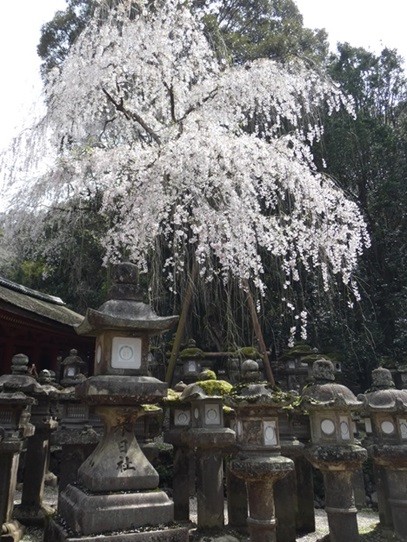
Having visited several of the important temples in Kyoto, on Saturday (6th April) Kaoru suggested that she drive Randall and me to the city of Nara, about 45 km (28 miles) south of Kyoto. After driving east through the town, we arrived at Nara Park at the foot of Mount Wakakusa. One of the oldest public parks in Japan, established in 1880, it contains most of the eight cultural assets that are grouped together in the "Historic Monuments of Ancient Nara" UNESCO World Heritage Site.
Nara, was the capital of Japan from 710 to 794 AD at which time Emperor Kammu decided that the Buddhist monks were becoming too powerful and influential in government and that he needed to reassert Imperial power. He moved the capital to Kyoto where he had a new palace build and could plan a larger, grander capital city. The Imperial Palace in Nara was simply abandoned and by the 12th century there was virtually nothing left above ground. Archeological excavations have continued at the site since 1959 and the main entrance gate and east palace garden have been restored and are open to the public. However, these are not within the boundaries of Nara Park so we did not see them, but instead we visited a shrine and some temples within the Park that also dated from the period when Nara was the capital city.
As a (maybe THE) leading expert on various aspects of native forests in Japan, Kaoru led us from the honesty-box car park that she had found on the outskirts of Nara Park into part of the 250-ha (620-acre) forest near the summit of Mount Kasuga. This hill is regarded as sacred because of its long association with the adjacent Kasuga-taisha or Kasuga Grand Shrine. Because of this, hunting and logging have been prohibited since 814 leading to the naming of this as Kasugayama Primeval Forest. Containing 175 species of trees, 60 bird species, and 1,180 species of insects, the Forest has been well-studied but it is not without human influence.
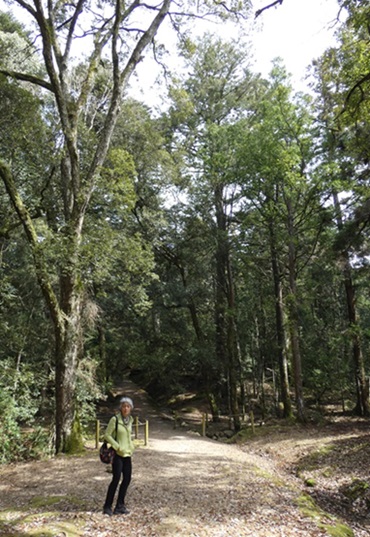
Kaoru leading us into the forest primeval at Kasugayama
Kaoru explained to us the concerns of over-grazing and browsing by the artificially high population of local deer. There is also an incursion of a species of podocarpus tree that is native to the coastal areas but which was introduced to these inland hills. Unappealing to the deer, these trees have an advantage over most of the locally native tree species and are increasing in density within the forest. We learned all of this as
we walked towards the site of the Shinto Kasuga-taisha Shrine (a.k.a. Kasuga Grand Shrine).
Our route took us past a huge number of stone and wooden toro (lanterns). Toro are very important in Shinto worship and come in two main types: platform lanterns often made completely of stone, or having a stone pedestal and cap with wooden or bronze lanterns between; and hanging lamps, usually suspended from the eaves of a roof. Originating in China, stone lanterns were first used only in Buddhist temples in Japan but after 794 they were also adopted in Shinto Shrines and private homes.

Moss-topped stone and wooden lanterns lined much of our route towards the Kasuga-taisha Shrine - many of these lanterns are sponsored by people or companies
There are more than 3,000 stone or bronze toro in and around Kasuga-taisha Shrine. In addition to the many stone lanterns lining the roadway, others were collected in groups or scattered into the woods around smaller shrines and torii gates. Torii gates at the entrances to shrines indicate the area within which the kami (spirits) reside and passing under a torii gate is often seen as a form of purification. With two vertical posts, torii gates have either one or two crossbeams, the latter being the most distinctly Japanese, and an internationally recognized symbol of the nation. I subsequently learned that the main torii at Kasuga-taisha is one of the oldest in Shinto and helped influence the style of torii seen across much of Japan, but it was not apparent to us while we were there which gate this was or if we even saw it.
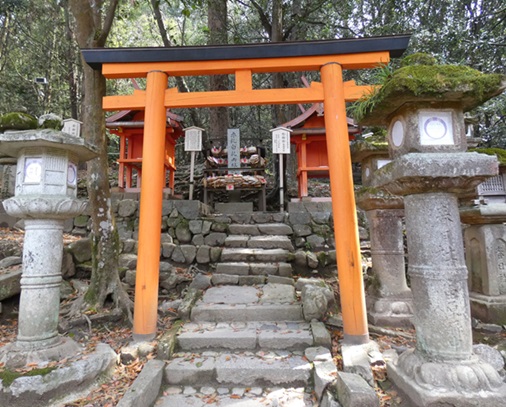
A torii gate with stone lanterns leading to a small shrine outside the main complex of Kasuga-taisha
Before entering the shrine complex, we passed under a large arbor supporting a canopy of huge old wisteria plants. Since they flower in late April and early May, we had to content ourselves with the glorious cherry blossoms, but photographs showed just how numerous, large, and beautifully colored the inflorescences would be.
Once we paid the admission fee (most larger shrines and temples charge a fee for visitors to enter the inner areas), we were within four cloisters which protected the main sanctuary, a treasure house, and several other halls including the halls for each of the four main kami that reside in this shrine. Kasuga-taisha Shrine was established in 768 (when Nara was the national capital) and has been rebuilt several times since then. According to legend, the shrine was founded when the first kami of Kasuga-taisha, Takemikazuchi, came from another shrine to protect Nara, and rode on the back of a white deer to the top of the adjacent Mount Wakakusa.
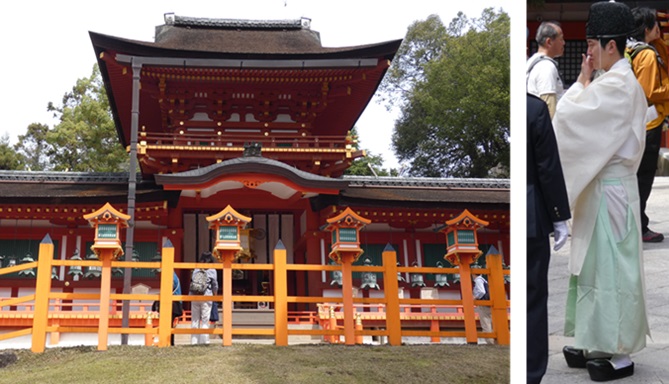
The main sanctuary at Kasuga-taisha Shrine and a Shinto priest waiting outside for a wedding party
In the courtyard in front of the main sanctuary, we were treated to the sight of a wedding couple having their photographs taken. They were not dressed in the typical types of kimonos and yukatas that we had been seeing elsewhere, but Kaoru explained that the bride was wearing a traditional junihitoe (= twelve layers). This was a style of formal court dress first worn by noble women and ladies-in-waiting in the Japanese Imperial Court after it moved to Kyoto. Despite the name, the number of silk layers varied, with a plain white inner garment covered by increasingly larger, different-colored, kimono-like robes. For special formal occasions, an overcoat and a long, skirt-like train would be added on top. The number of layers was greatest in the earlier periods, with a total weight that could be as much as 20 kilograms (44 lb).
In addition to the hot and heavy junihitoe (I counted at least 9 visible layers), the bride was wearing a thick long wig. She needed at least two assistants to move and carry the train of the robe's long outer layer. The couple must have been very motivated to go to this much effort and expense to wear such elaborate garments for their wedding, and to have it in a time and place that would be scrutinized by so many tourists.
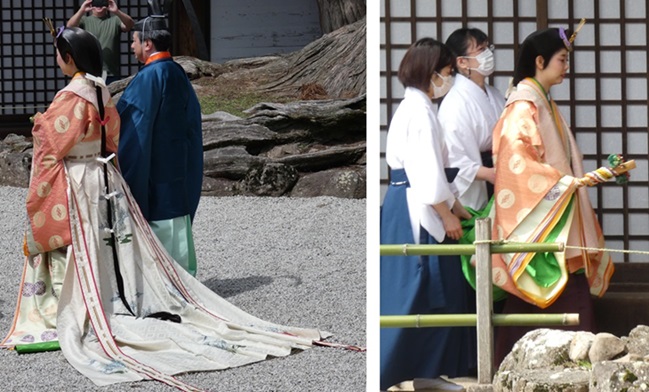
A wedding couple posing for photographs and heading towards the main sanctuary in Kasuga-taisha shrine - the bride is wearing a junihitoe ("twelve layers") and carries a hiogi, an elaborate fan made out of slats of cypress wood
After admiring the wedding party, we followed the designated trail through several long arcades of hanging lanterns mostly of bronze, but some were a gold color although probably not actually gold. It must be quite a chore to light all of them but apparently this only happens during a couple of important festivals.

A composite of two photographs showing long rows of bronze and shiny gold hanging lanterns in the Kasuga-taisha Shrine
However, another treat was in store for us and after passing between two black curtains, we entered a dark hall full of lanterns that were lit (probably by electrical lights for safety). We followed the path into the hall, around the far end of the handrail, and back out, thankful that there were no unseen stairs to trip us up. It was a very beautiful and peaceful room.
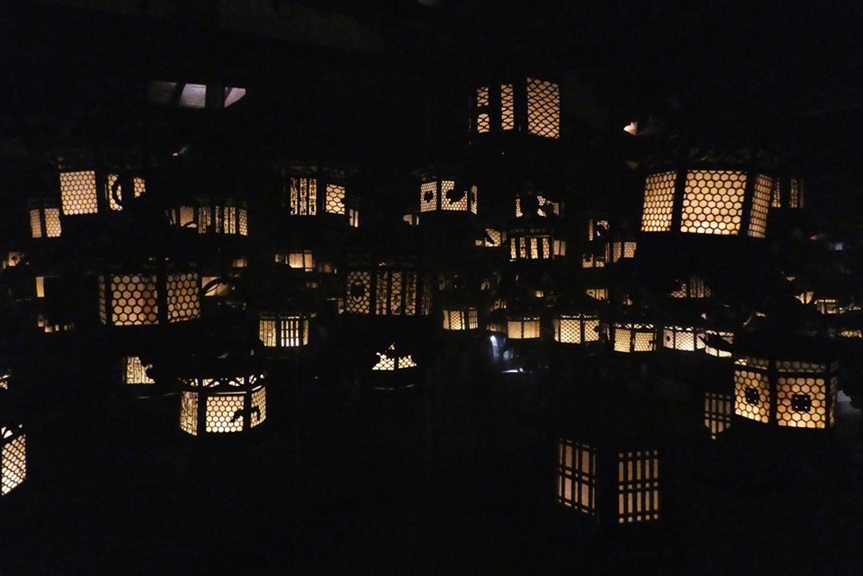
Just a few of the many lit lanterns in the darkened hall at Kashuga-taisha Shrine
Once we left the central part of the shrine and started walking northward, we found ourselves approached by many of the Nara deer. When we had first entered the forest, we had seen a sign warning visitors about the potential dangers of these deer. However, it was not until we realized that there were so many of them and they were used to being fed deer biscuits, which could be purchased all around the park, did we understand that greedy deer and naïve people looking for a cute photo or to touch an animal could result in dangerous interactions.
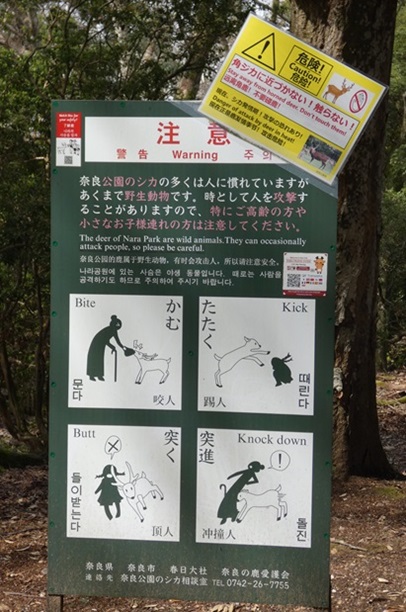
One of many signs warning about the potential danger of the Nara deer
The wild deer living around Kasuga-taisha Shrine and Mount Wakakusa were initially considered divine and sacred because of the legend of the first of the shrine's kami riding up the mountain on a white deer. Killing one of these deer was a capital offence until 1637, the last recorded date of a breach of that law. Their divine status was officially removed after World War II but the deer are now protected as natural monuments.
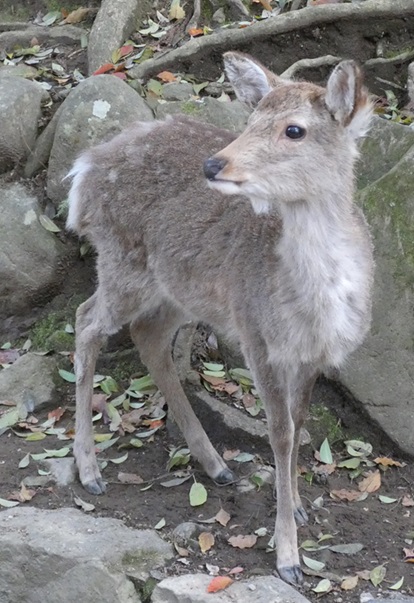
A sika deer with a shaggy coat and a few spots
The Nara deer are sika deer (Cervus nippon), also known as the Northern spotted deer or the Japanese deer, native to much of East Asia and introduced to many other parts of the world. It is an uncommon species that has been extirpated in most areas of its native range, except in Japan, where it is overabundant and present in very large numbers. They are not to be confused with the Sitka deer or Sitka black-tailed deer (Odocoileus hemionus sitkensis) which is a subspecies of mule deer that inhabits the coastal rainforests of northern British Columbia and southeastern Alaska. Sika deer is one of the few deer species that does not lose its spots upon reaching maturity. Spot patterns vary with region, and Japanese populations tend to have very faint spots.
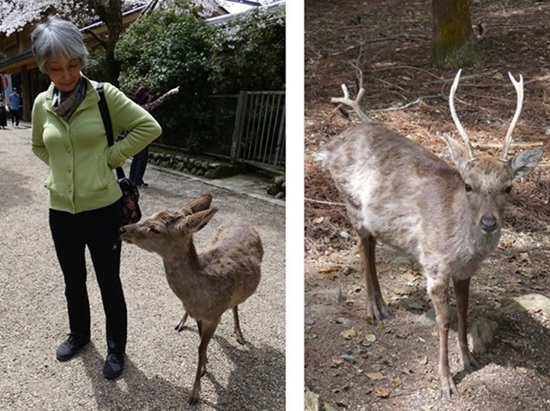
Nara deer are not very tall, as seen compared to Kaoru, and for visitor's safety, the antlers of most of the male deer in the park are removed, but a few did not get the memo
While the deer are a very popular tourist attraction, there are some problems related to over-population and feeding by tourists. There are more than 1,200 deer roaming around Nara Park but the population was high as 1,500 in 2017, a very high density in the park area of 660 hectares (1,600 acres). Annual number of people injured by deer, mostly tourists feeding the deer, have been as high as 121 in 2016. Some culling of the population on the outskirts of the city was initiated in 2017 and new, multilanguage signs to warn of injuries were posted in 2018. To reduce injuries, the antlers of males are removed each year, although a few deer escape capture and retain them.
Studies show that while typical male sika deer weigh around 50 kg (110 lb), those in Nara Park averaged about 30 kg (66 lb) and showed signs of malnutrition. Although the deer population is artificially maintained above the natural carrying capacity of the area by the supplemental food source of crackers fed to the deer by tourists, those crackers are made of wheat flour and rice bran and are unbalanced in nutritional content.
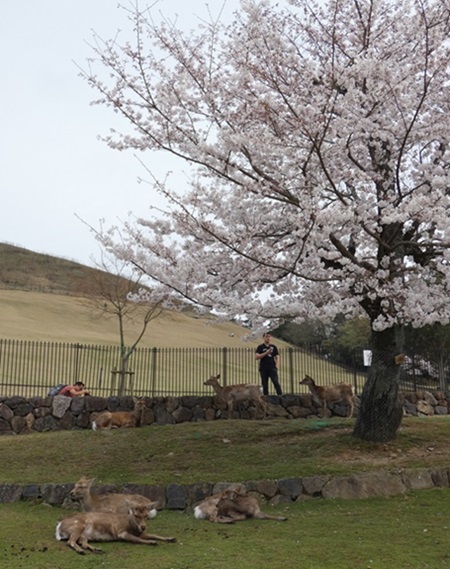
Deer resting beneath a cherry tree with Mount Wakakusa beyond
Continuing our northward walk, we passed an area of the park full of blossoming cherry trees with deer resting underneath. Beyond was the grassy slope of Mount Wakakusa which was topped by an area of small deciduous trees. Kaoru explained that this was a monospecific thicket of Chinese tallow trees. This species is native to China and is highly invasive in Florida. The deer will not touch the tallow, while eating all of the surrounding vegetation, creating a self-sustaining non-native plant population.
In addition to the deer, we did see a few birds. Apart from the ubiquitous house sparrows, the most common native bird seemed to be the brown eared bulbul. Perhaps the most spectacular bird that we saw was the blue rock-thrush. Coincidentally, the first ever sighting of a blue rock-thrush in the US was made in Oregon, just a couple of weeks later.
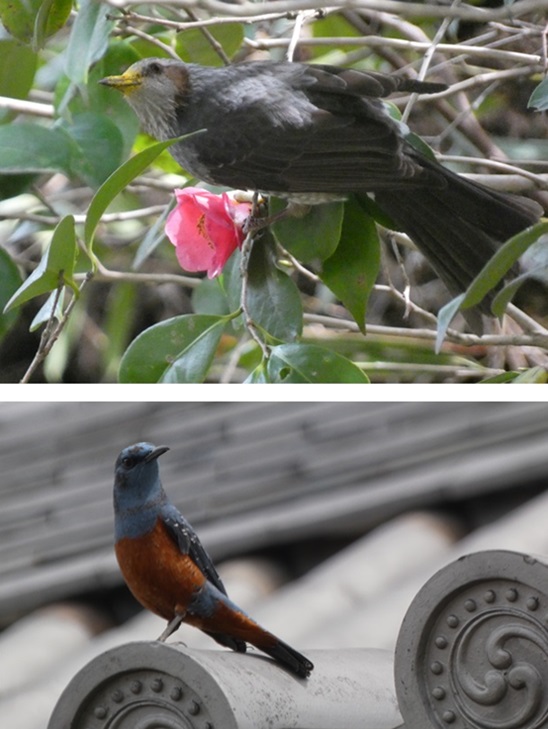
The brown-eared bulbul (to 28 cm), this one had just smothered its face with pollen from the camellia flower and a blue rock-thrush (to 23 cm) on a temple roof
We had slices of quiche for lunch at a picnic table in the woods, under the bright green and red young leaves of maple trees. With all the emphasis on the cherry blossoms, it was easy to ignore the magnificent bright colors of the deciduous trees that were unfurling their new leaves. In addition to the many maples in gardens and woods, the ginkgo trees that were planted, and severely pruned, along many city streets were just starting to bud out.
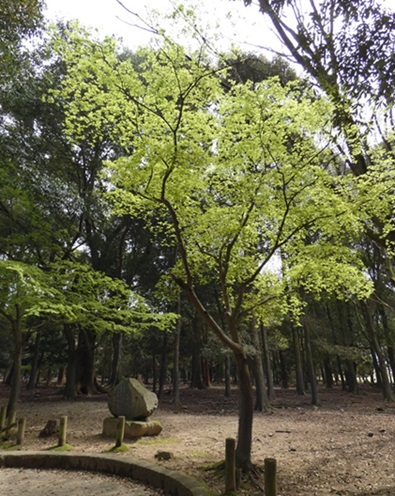
Bright green leaves unfurling on a maple tree in Nara Park
Of course, Randall and I were still completely smitten with the cherry blossoms although by now we were particularly looking for unusual flower shades or tree shapes. We were not always quite sure whether we were looking at cherry or plum blossoms.
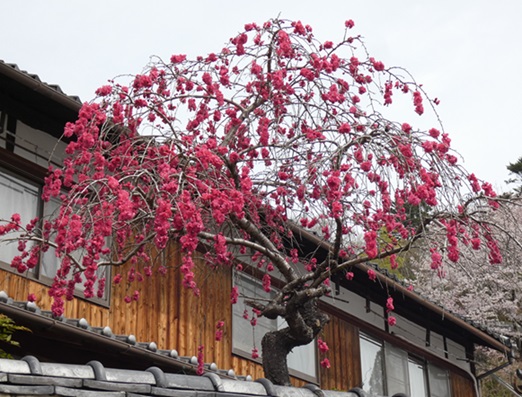
A weeping tree seen in Nara Park - the dark blossom color suggests that it is more likely to be a flowering plum than cherry but we did not get close enough to be sure
On our way towards the central part of Todai-ji Buddhist Temple, our final destination in Nara Park, we passed the large Hokke-do Hall (Sangatsudo), various other halls, shrines, and a bathhouse. The Hokke-do (Lotus) Hall is the oldest structure at Todai-ji built between 740 and 747.
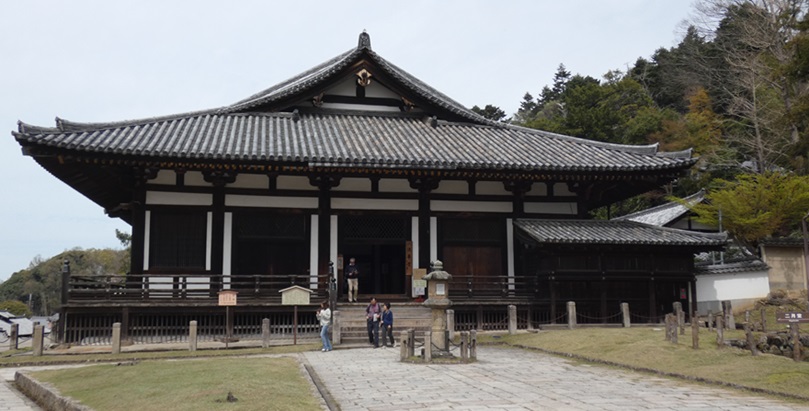
The side view of Hokke-do Hall (Sangatsudo)
Approaching the center of Todai-ji Temple, we came across a huge, ornate, gold-painted tower. This was a sorin, a vertical shaft which originally sat on top of one of two 100-m (328-feet) tall pagodas that flanked the Great Buddha Hall of Todai-ji Temple. These pagodas were the tallest structures of their kind in Japan but both were destroyed by earthquakes. This sorin finial stands where the eastern pagoda had been.
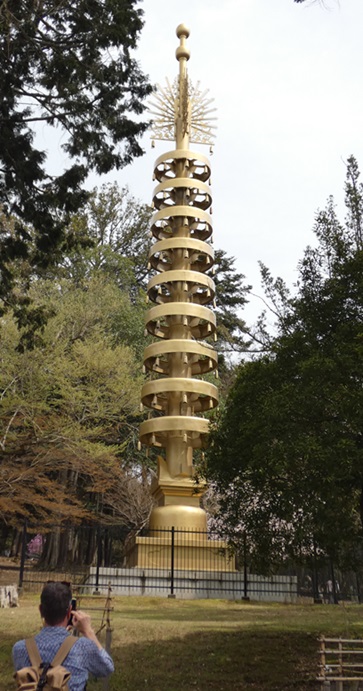
Sorin finial in the place where a large pagoda used to be next to the Todai-ji Temple
Next, we passed the temple's bell tower with its sweeping, curved rooftop. Completed by 1210 the tower contains a massive bronze bell which weights 26 tons and dates from the founding of Todai-ji in the mid-eighth century. Known for its long ring, produced by swinging a large wooden pole against its outside, it is one of the Three Famous Bells of Japan.

Left - The bell tower at Todai-ji Temple (the people seated just in front give a sense of scale) but the pole that is swung to hit the bell is not visible on the far side: Right - the pole to ring a smaller bell at Konkai-Komyo-ji Temple
It was not difficult to find the visitors' entrance to the central part of Todai-ji Temple as there was a long line. Fortunately, it moved fairly quickly and going inside was definitely worth a little wait. Todai-ji (a.k.a. Eastern Great Temple) was originally founded in 738 but did not open until 752. Fires have necessitated several reconstructions with the most significant being the completion of the Great Buddha Hall in 1709, the building that currently exists. Todai-ji was a center of higher learning and study in addition to being a place of Buddhist worship and training, so the original complex had a library and lecture hall in addition to a dining room and residential quarters for the monks.
In the early eighth century, Japan suffered from a series of disasters and epidemics prompting Emperor Shomu to issue an edict in 741 to promote the construction of provincial temples throughout the nation. It was hoped that such devotion would encourage Buddha to protect his country and in 743 Emperor Shomu commissioned a giant statue of Buddha (or Daibutsu) to be built and housed in a massive hall at Todai-ji Temple. The Great Buddha Hall was the largest wooden building in the world until 1998 when it was surpassed by a modern Japanese baseball stadium.
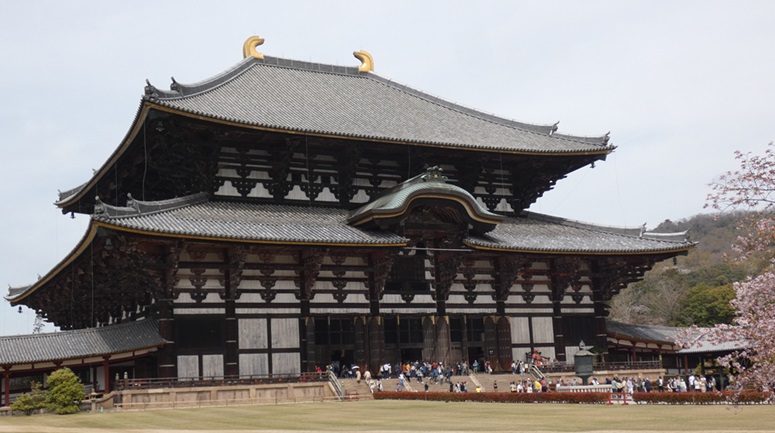
The Great Buddha Hall at Todai-ji Temple - 57 m (187 ft) long, 50 m (160 ft) wide, and 49 m (161 ft) tall
Surrounded by shady cloisters, a large lawn stretches in front of the Great Buddha Hall. Just before reaching the Hall's entrance, we passed a huge bronze toro which has been declared a National Treasure. This octagonal lantern dates from the founding of Tōdai-ji.
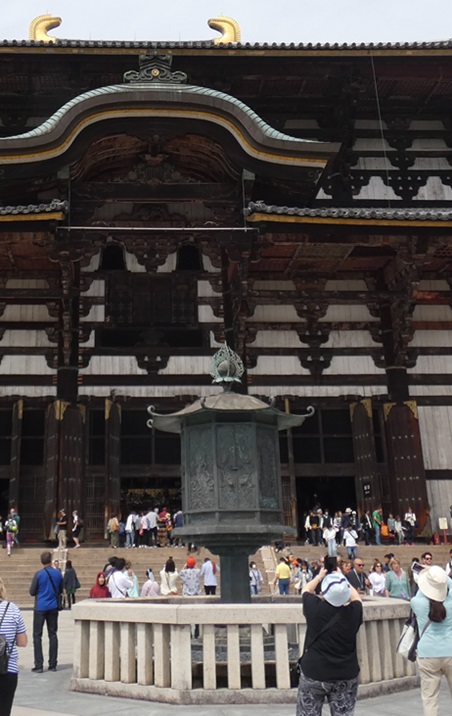
The massive bronze toro outside the front of the Great Buddha Hall - the face of the Buddha statue inside the hall is behind the shuttered window seen just above the top of the toro in this picture
Once inside the hall, we were in awe of the massive bronze statue of the Buddha Vairocana, the largest of such structures in the world. Considered a transcendent form of the historical Buddha Shakyamuni, Vairocana is the celestial Buddha who resides at the center of the cosmos (a.k.a. Sun-, First-, or Primordial-Buddha). Photography was not allowed directly in front of the Buddha statue but whether this was a sign of respect or for safer crowd control, we could not tell.
According to records kept at the Tōdai-ji, more than 2.6 million people across Japan made contributions (rice, wood, metal, cloth, or labor) towards the construction of the statue and its Hall. The 15-m (50-feet) high statue was built in three bronze castings over three years and occupying 350,000 workers. It used most of Japan's supply of bronze, and all of the gold for the body-surrounding halo had to be imported. An "eye-opening" ceremony in 752, a year after completion of the statue, was performed by a venerated Indian priest and was attended by Emperor Shomu, 10,000 monks, and 4,000 dancers.
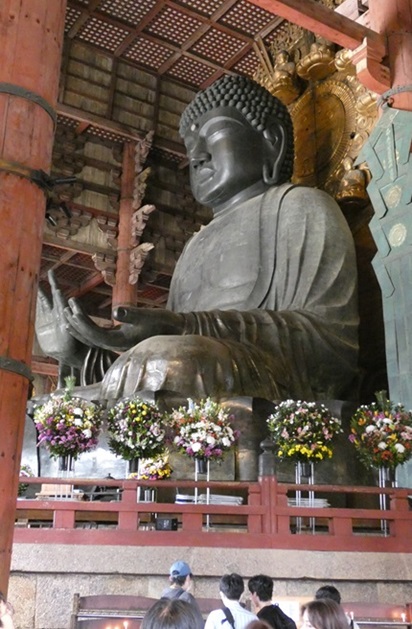
The Great Budda statue
Parts of the statue have been recast at various times, such as after fire or earthquake damage. For example, the current head was made in the Edo period (1615 - 1867) and has 960 curls. The Great Buddha is flanked on either side by a golden statue of a bodhisattva. A bodhisattva is a person who is on the path towards bodhi ('awakening') or Buddhahood.
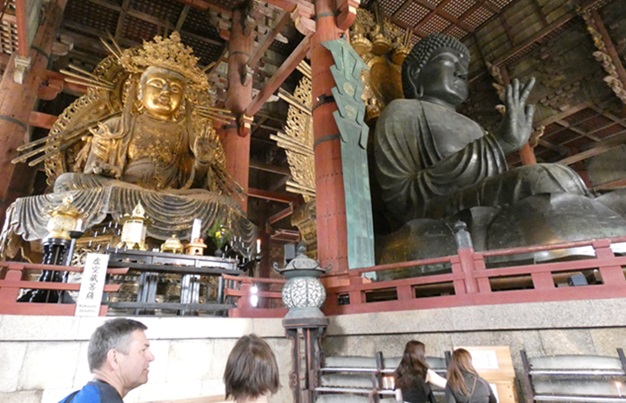
Visitors give some sense of scale of the Great Buddha to the right of the golden bodhisattva Kokuuzo-bosatsu
Behind the statues of the seated Buddha and bodhisattvas are two fierce-looking guardians. These tall statues of standing warriors are carved from wood.
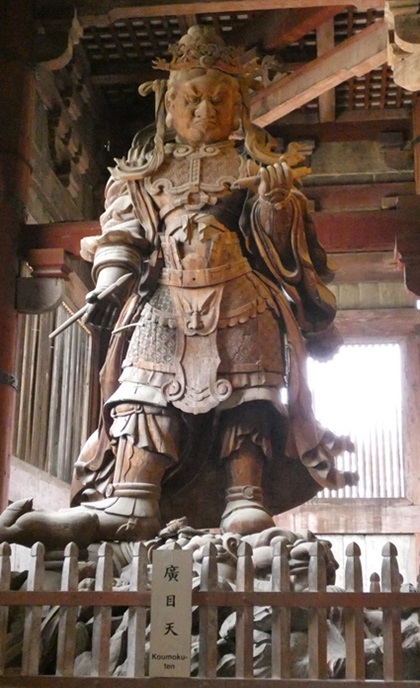
Koumokuten - one of the two guardians behind the Buddha and bodhisattva statues
Between the guardians are scale models of the temple in its original form, the reconstruction after the 1180 fire, and the current temple which was rebuilt after the 1567 fire. All Great Buddha Halls had the same height and depths and the original and second halls were same width with 11 bays. Due to funding constraints, however, the current hall is only seven bays wide.
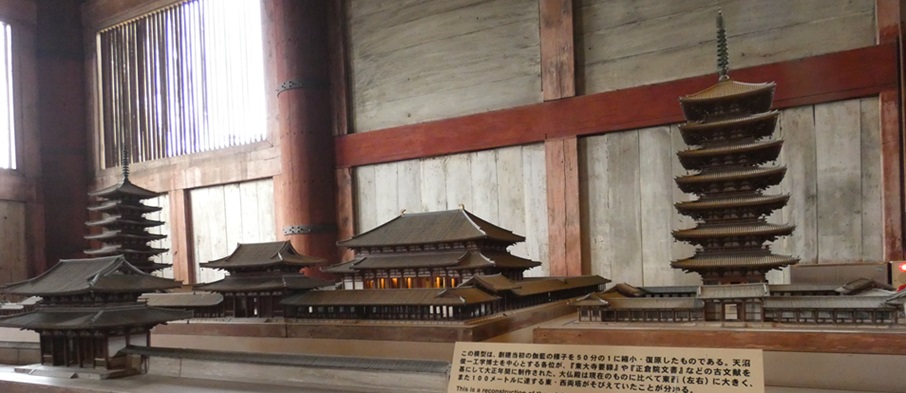
1:50 scale model of the original temple showing the wider Great Buddha Hall in the center and the massive seven-tier pagodas, with their tall sorin finials, on either side
Looking for aspects of nature in the Great Buddha Hall, I noticed a pair of large butterflies at the base of a bronze sculpture. Butterflies are often depicted in Buddhist art as representing the emergence, from the tomb on earth of the chrysalis, into a new life free of restrictions. Only on later inspection of my photograph did I notice that what I had assumed were butterflies (insects with six legs) might have been something else as they each had eight legs!
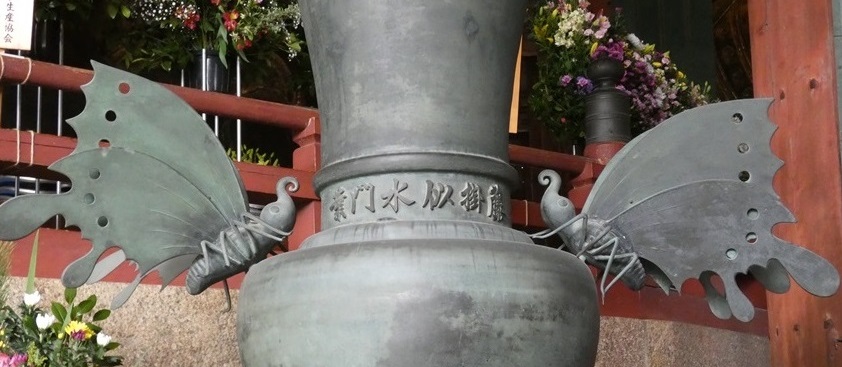
Butterflies with extra pairs of legs?
The other natural prominent features within the hall were the many flower arrangements. These were fairly typical of modern styles of flower arranging but reminded us that ikebana "arranging flowers" or "making flowers alive" is a long-practiced Japanese tradition. It is one of the three classical Japanese arts of refinement, along with kodo, the appreciation of incense, and chado, the traditional tea ceremony. The principles of ikebana are: Silence - a time to observe and work with nature; minimalism - influenced by Buddhist ideals of simplicity; and shape and line - emphasized to convey feelings or emotions to a viewer in the manner of other forms of art.

A couple of examples of the flower arrangements in the Great Buddha Hall - a bit larger and denser than more classic examples of ikebana
In addition to flower arranging, it is a Japanese tradition to also appreciate the transient beauty of flowers through hanami or "flower viewing". This term usually applies to the appreciation of cherry, or sometimes plum trees. The cherry blossom front is announced each year by the Japan Meteorological Agency, starting in Okinawa in January and spreading across the rest of the nation from late March to early May. Hanami typically consists of having a picnic or party beneath the cherry trees during the day or night.
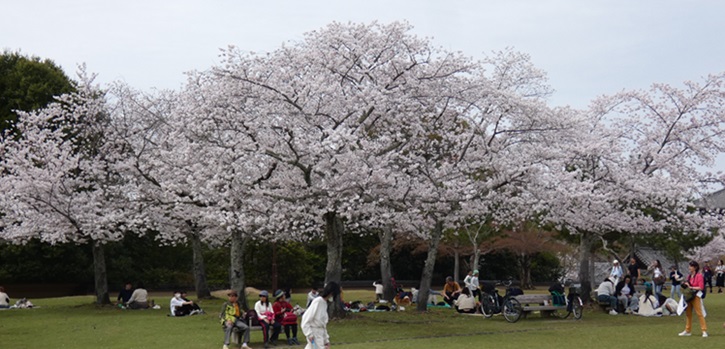
Families enjoying picnics beneath a few of the many cherry trees in Nara Park
There is plenty more to see in Nara Park including two large museums, but by the time we returned to Kaoru's car we had walked at least 5 km (3 miles). That may not seem far for a hike but was plenty when wandering slowly through shrines and temples with only a short break to sit down for lunch. Needless to say, we were very happy to spend a quiet evening relaxing in the condo especially as Randall and I were going to be staying in a traditional Japanese inn the following night. Since we would be dining out for the next two evenings, we also thoroughly appreciated Kaoru's willingness to prepare an excellent dinner that included miso soup, some sushi, and delicious baked cod. Yum!
Nara, was the capital of Japan from 710 to 794 AD at which time Emperor Kammu decided that the Buddhist monks were becoming too powerful and influential in government and that he needed to reassert Imperial power. He moved the capital to Kyoto where he had a new palace build and could plan a larger, grander capital city. The Imperial Palace in Nara was simply abandoned and by the 12th century there was virtually nothing left above ground. Archeological excavations have continued at the site since 1959 and the main entrance gate and east palace garden have been restored and are open to the public. However, these are not within the boundaries of Nara Park so we did not see them, but instead we visited a shrine and some temples within the Park that also dated from the period when Nara was the capital city.
As a (maybe THE) leading expert on various aspects of native forests in Japan, Kaoru led us from the honesty-box car park that she had found on the outskirts of Nara Park into part of the 250-ha (620-acre) forest near the summit of Mount Kasuga. This hill is regarded as sacred because of its long association with the adjacent Kasuga-taisha or Kasuga Grand Shrine. Because of this, hunting and logging have been prohibited since 814 leading to the naming of this as Kasugayama Primeval Forest. Containing 175 species of trees, 60 bird species, and 1,180 species of insects, the Forest has been well-studied but it is not without human influence.

Kaoru leading us into the forest primeval at Kasugayama
Kaoru explained to us the concerns of over-grazing and browsing by the artificially high population of local deer. There is also an incursion of a species of podocarpus tree that is native to the coastal areas but which was introduced to these inland hills. Unappealing to the deer, these trees have an advantage over most of the locally native tree species and are increasing in density within the forest. We learned all of this as
we walked towards the site of the Shinto Kasuga-taisha Shrine (a.k.a. Kasuga Grand Shrine).
Our route took us past a huge number of stone and wooden toro (lanterns). Toro are very important in Shinto worship and come in two main types: platform lanterns often made completely of stone, or having a stone pedestal and cap with wooden or bronze lanterns between; and hanging lamps, usually suspended from the eaves of a roof. Originating in China, stone lanterns were first used only in Buddhist temples in Japan but after 794 they were also adopted in Shinto Shrines and private homes.

Moss-topped stone and wooden lanterns lined much of our route towards the Kasuga-taisha Shrine - many of these lanterns are sponsored by people or companies
There are more than 3,000 stone or bronze toro in and around Kasuga-taisha Shrine. In addition to the many stone lanterns lining the roadway, others were collected in groups or scattered into the woods around smaller shrines and torii gates. Torii gates at the entrances to shrines indicate the area within which the kami (spirits) reside and passing under a torii gate is often seen as a form of purification. With two vertical posts, torii gates have either one or two crossbeams, the latter being the most distinctly Japanese, and an internationally recognized symbol of the nation. I subsequently learned that the main torii at Kasuga-taisha is one of the oldest in Shinto and helped influence the style of torii seen across much of Japan, but it was not apparent to us while we were there which gate this was or if we even saw it.

A torii gate with stone lanterns leading to a small shrine outside the main complex of Kasuga-taisha
Before entering the shrine complex, we passed under a large arbor supporting a canopy of huge old wisteria plants. Since they flower in late April and early May, we had to content ourselves with the glorious cherry blossoms, but photographs showed just how numerous, large, and beautifully colored the inflorescences would be.
Once we paid the admission fee (most larger shrines and temples charge a fee for visitors to enter the inner areas), we were within four cloisters which protected the main sanctuary, a treasure house, and several other halls including the halls for each of the four main kami that reside in this shrine. Kasuga-taisha Shrine was established in 768 (when Nara was the national capital) and has been rebuilt several times since then. According to legend, the shrine was founded when the first kami of Kasuga-taisha, Takemikazuchi, came from another shrine to protect Nara, and rode on the back of a white deer to the top of the adjacent Mount Wakakusa.

The main sanctuary at Kasuga-taisha Shrine and a Shinto priest waiting outside for a wedding party
In the courtyard in front of the main sanctuary, we were treated to the sight of a wedding couple having their photographs taken. They were not dressed in the typical types of kimonos and yukatas that we had been seeing elsewhere, but Kaoru explained that the bride was wearing a traditional junihitoe (= twelve layers). This was a style of formal court dress first worn by noble women and ladies-in-waiting in the Japanese Imperial Court after it moved to Kyoto. Despite the name, the number of silk layers varied, with a plain white inner garment covered by increasingly larger, different-colored, kimono-like robes. For special formal occasions, an overcoat and a long, skirt-like train would be added on top. The number of layers was greatest in the earlier periods, with a total weight that could be as much as 20 kilograms (44 lb).
In addition to the hot and heavy junihitoe (I counted at least 9 visible layers), the bride was wearing a thick long wig. She needed at least two assistants to move and carry the train of the robe's long outer layer. The couple must have been very motivated to go to this much effort and expense to wear such elaborate garments for their wedding, and to have it in a time and place that would be scrutinized by so many tourists.

A wedding couple posing for photographs and heading towards the main sanctuary in Kasuga-taisha shrine - the bride is wearing a junihitoe ("twelve layers") and carries a hiogi, an elaborate fan made out of slats of cypress wood
After admiring the wedding party, we followed the designated trail through several long arcades of hanging lanterns mostly of bronze, but some were a gold color although probably not actually gold. It must be quite a chore to light all of them but apparently this only happens during a couple of important festivals.

A composite of two photographs showing long rows of bronze and shiny gold hanging lanterns in the Kasuga-taisha Shrine
However, another treat was in store for us and after passing between two black curtains, we entered a dark hall full of lanterns that were lit (probably by electrical lights for safety). We followed the path into the hall, around the far end of the handrail, and back out, thankful that there were no unseen stairs to trip us up. It was a very beautiful and peaceful room.

Just a few of the many lit lanterns in the darkened hall at Kashuga-taisha Shrine
Once we left the central part of the shrine and started walking northward, we found ourselves approached by many of the Nara deer. When we had first entered the forest, we had seen a sign warning visitors about the potential dangers of these deer. However, it was not until we realized that there were so many of them and they were used to being fed deer biscuits, which could be purchased all around the park, did we understand that greedy deer and naïve people looking for a cute photo or to touch an animal could result in dangerous interactions.

One of many signs warning about the potential danger of the Nara deer
The wild deer living around Kasuga-taisha Shrine and Mount Wakakusa were initially considered divine and sacred because of the legend of the first of the shrine's kami riding up the mountain on a white deer. Killing one of these deer was a capital offence until 1637, the last recorded date of a breach of that law. Their divine status was officially removed after World War II but the deer are now protected as natural monuments.

A sika deer with a shaggy coat and a few spots
The Nara deer are sika deer (Cervus nippon), also known as the Northern spotted deer or the Japanese deer, native to much of East Asia and introduced to many other parts of the world. It is an uncommon species that has been extirpated in most areas of its native range, except in Japan, where it is overabundant and present in very large numbers. They are not to be confused with the Sitka deer or Sitka black-tailed deer (Odocoileus hemionus sitkensis) which is a subspecies of mule deer that inhabits the coastal rainforests of northern British Columbia and southeastern Alaska. Sika deer is one of the few deer species that does not lose its spots upon reaching maturity. Spot patterns vary with region, and Japanese populations tend to have very faint spots.

Nara deer are not very tall, as seen compared to Kaoru, and for visitor's safety, the antlers of most of the male deer in the park are removed, but a few did not get the memo
While the deer are a very popular tourist attraction, there are some problems related to over-population and feeding by tourists. There are more than 1,200 deer roaming around Nara Park but the population was high as 1,500 in 2017, a very high density in the park area of 660 hectares (1,600 acres). Annual number of people injured by deer, mostly tourists feeding the deer, have been as high as 121 in 2016. Some culling of the population on the outskirts of the city was initiated in 2017 and new, multilanguage signs to warn of injuries were posted in 2018. To reduce injuries, the antlers of males are removed each year, although a few deer escape capture and retain them.
Studies show that while typical male sika deer weigh around 50 kg (110 lb), those in Nara Park averaged about 30 kg (66 lb) and showed signs of malnutrition. Although the deer population is artificially maintained above the natural carrying capacity of the area by the supplemental food source of crackers fed to the deer by tourists, those crackers are made of wheat flour and rice bran and are unbalanced in nutritional content.

Deer resting beneath a cherry tree with Mount Wakakusa beyond
Continuing our northward walk, we passed an area of the park full of blossoming cherry trees with deer resting underneath. Beyond was the grassy slope of Mount Wakakusa which was topped by an area of small deciduous trees. Kaoru explained that this was a monospecific thicket of Chinese tallow trees. This species is native to China and is highly invasive in Florida. The deer will not touch the tallow, while eating all of the surrounding vegetation, creating a self-sustaining non-native plant population.
In addition to the deer, we did see a few birds. Apart from the ubiquitous house sparrows, the most common native bird seemed to be the brown eared bulbul. Perhaps the most spectacular bird that we saw was the blue rock-thrush. Coincidentally, the first ever sighting of a blue rock-thrush in the US was made in Oregon, just a couple of weeks later.

The brown-eared bulbul (to 28 cm), this one had just smothered its face with pollen from the camellia flower and a blue rock-thrush (to 23 cm) on a temple roof
We had slices of quiche for lunch at a picnic table in the woods, under the bright green and red young leaves of maple trees. With all the emphasis on the cherry blossoms, it was easy to ignore the magnificent bright colors of the deciduous trees that were unfurling their new leaves. In addition to the many maples in gardens and woods, the ginkgo trees that were planted, and severely pruned, along many city streets were just starting to bud out.

Bright green leaves unfurling on a maple tree in Nara Park
Of course, Randall and I were still completely smitten with the cherry blossoms although by now we were particularly looking for unusual flower shades or tree shapes. We were not always quite sure whether we were looking at cherry or plum blossoms.

A weeping tree seen in Nara Park - the dark blossom color suggests that it is more likely to be a flowering plum than cherry but we did not get close enough to be sure
On our way towards the central part of Todai-ji Buddhist Temple, our final destination in Nara Park, we passed the large Hokke-do Hall (Sangatsudo), various other halls, shrines, and a bathhouse. The Hokke-do (Lotus) Hall is the oldest structure at Todai-ji built between 740 and 747.

The side view of Hokke-do Hall (Sangatsudo)
Approaching the center of Todai-ji Temple, we came across a huge, ornate, gold-painted tower. This was a sorin, a vertical shaft which originally sat on top of one of two 100-m (328-feet) tall pagodas that flanked the Great Buddha Hall of Todai-ji Temple. These pagodas were the tallest structures of their kind in Japan but both were destroyed by earthquakes. This sorin finial stands where the eastern pagoda had been.

Sorin finial in the place where a large pagoda used to be next to the Todai-ji Temple
Next, we passed the temple's bell tower with its sweeping, curved rooftop. Completed by 1210 the tower contains a massive bronze bell which weights 26 tons and dates from the founding of Todai-ji in the mid-eighth century. Known for its long ring, produced by swinging a large wooden pole against its outside, it is one of the Three Famous Bells of Japan.

Left - The bell tower at Todai-ji Temple (the people seated just in front give a sense of scale) but the pole that is swung to hit the bell is not visible on the far side: Right - the pole to ring a smaller bell at Konkai-Komyo-ji Temple
It was not difficult to find the visitors' entrance to the central part of Todai-ji Temple as there was a long line. Fortunately, it moved fairly quickly and going inside was definitely worth a little wait. Todai-ji (a.k.a. Eastern Great Temple) was originally founded in 738 but did not open until 752. Fires have necessitated several reconstructions with the most significant being the completion of the Great Buddha Hall in 1709, the building that currently exists. Todai-ji was a center of higher learning and study in addition to being a place of Buddhist worship and training, so the original complex had a library and lecture hall in addition to a dining room and residential quarters for the monks.
In the early eighth century, Japan suffered from a series of disasters and epidemics prompting Emperor Shomu to issue an edict in 741 to promote the construction of provincial temples throughout the nation. It was hoped that such devotion would encourage Buddha to protect his country and in 743 Emperor Shomu commissioned a giant statue of Buddha (or Daibutsu) to be built and housed in a massive hall at Todai-ji Temple. The Great Buddha Hall was the largest wooden building in the world until 1998 when it was surpassed by a modern Japanese baseball stadium.

The Great Buddha Hall at Todai-ji Temple - 57 m (187 ft) long, 50 m (160 ft) wide, and 49 m (161 ft) tall
Surrounded by shady cloisters, a large lawn stretches in front of the Great Buddha Hall. Just before reaching the Hall's entrance, we passed a huge bronze toro which has been declared a National Treasure. This octagonal lantern dates from the founding of Tōdai-ji.

The massive bronze toro outside the front of the Great Buddha Hall - the face of the Buddha statue inside the hall is behind the shuttered window seen just above the top of the toro in this picture
Once inside the hall, we were in awe of the massive bronze statue of the Buddha Vairocana, the largest of such structures in the world. Considered a transcendent form of the historical Buddha Shakyamuni, Vairocana is the celestial Buddha who resides at the center of the cosmos (a.k.a. Sun-, First-, or Primordial-Buddha). Photography was not allowed directly in front of the Buddha statue but whether this was a sign of respect or for safer crowd control, we could not tell.
According to records kept at the Tōdai-ji, more than 2.6 million people across Japan made contributions (rice, wood, metal, cloth, or labor) towards the construction of the statue and its Hall. The 15-m (50-feet) high statue was built in three bronze castings over three years and occupying 350,000 workers. It used most of Japan's supply of bronze, and all of the gold for the body-surrounding halo had to be imported. An "eye-opening" ceremony in 752, a year after completion of the statue, was performed by a venerated Indian priest and was attended by Emperor Shomu, 10,000 monks, and 4,000 dancers.

The Great Budda statue
Parts of the statue have been recast at various times, such as after fire or earthquake damage. For example, the current head was made in the Edo period (1615 - 1867) and has 960 curls. The Great Buddha is flanked on either side by a golden statue of a bodhisattva. A bodhisattva is a person who is on the path towards bodhi ('awakening') or Buddhahood.

Visitors give some sense of scale of the Great Buddha to the right of the golden bodhisattva Kokuuzo-bosatsu
Behind the statues of the seated Buddha and bodhisattvas are two fierce-looking guardians. These tall statues of standing warriors are carved from wood.

Koumokuten - one of the two guardians behind the Buddha and bodhisattva statues
Between the guardians are scale models of the temple in its original form, the reconstruction after the 1180 fire, and the current temple which was rebuilt after the 1567 fire. All Great Buddha Halls had the same height and depths and the original and second halls were same width with 11 bays. Due to funding constraints, however, the current hall is only seven bays wide.

1:50 scale model of the original temple showing the wider Great Buddha Hall in the center and the massive seven-tier pagodas, with their tall sorin finials, on either side
Looking for aspects of nature in the Great Buddha Hall, I noticed a pair of large butterflies at the base of a bronze sculpture. Butterflies are often depicted in Buddhist art as representing the emergence, from the tomb on earth of the chrysalis, into a new life free of restrictions. Only on later inspection of my photograph did I notice that what I had assumed were butterflies (insects with six legs) might have been something else as they each had eight legs!

Butterflies with extra pairs of legs?
The other natural prominent features within the hall were the many flower arrangements. These were fairly typical of modern styles of flower arranging but reminded us that ikebana "arranging flowers" or "making flowers alive" is a long-practiced Japanese tradition. It is one of the three classical Japanese arts of refinement, along with kodo, the appreciation of incense, and chado, the traditional tea ceremony. The principles of ikebana are: Silence - a time to observe and work with nature; minimalism - influenced by Buddhist ideals of simplicity; and shape and line - emphasized to convey feelings or emotions to a viewer in the manner of other forms of art.

A couple of examples of the flower arrangements in the Great Buddha Hall - a bit larger and denser than more classic examples of ikebana
In addition to flower arranging, it is a Japanese tradition to also appreciate the transient beauty of flowers through hanami or "flower viewing". This term usually applies to the appreciation of cherry, or sometimes plum trees. The cherry blossom front is announced each year by the Japan Meteorological Agency, starting in Okinawa in January and spreading across the rest of the nation from late March to early May. Hanami typically consists of having a picnic or party beneath the cherry trees during the day or night.

Families enjoying picnics beneath a few of the many cherry trees in Nara Park
There is plenty more to see in Nara Park including two large museums, but by the time we returned to Kaoru's car we had walked at least 5 km (3 miles). That may not seem far for a hike but was plenty when wandering slowly through shrines and temples with only a short break to sit down for lunch. Needless to say, we were very happy to spend a quiet evening relaxing in the condo especially as Randall and I were going to be staying in a traditional Japanese inn the following night. Since we would be dining out for the next two evenings, we also thoroughly appreciated Kaoru's willingness to prepare an excellent dinner that included miso soup, some sushi, and delicious baked cod. Yum!
Springtime blossoms in Japan
05 April 2024 | We are in Kyoto, Japan: Tregoning is in Mersin Marina, Mersin, Türkiye
Alison Stocker | Photo: Cherry blossoms and tourists along the Philosopher’s Walk, Kyoto, Japan

As the "designated worrier" aboard Tregoning, it is my job to anticipate everything that can go wrong, a role at which I am quite skilled. As foreshadowed in my post from Toronto Airport, I was concerned that we might miss our connecting flight in Tokyo due to delays in Customs explaining that the strange collection of boat parts in our luggage was not going to remain in Japan. Well, I got the consequent correct but not the cause.
Our more than 13-hour daytime flight from Toronto to Tokyo gave us plenty of opportunities to enjoy the airline's movies (including happily watching Barbie for a second time). We also had some spectacular views as we flew over northern Canada and the North Slope Basin of Alaksa. Flying over the Bering Strait, we crossed the International Dateline, cutting short Tuesday (2nd April) and thrusting us well into Wednesday.

Flying over the North Slope Basin of Alaska
We landed about on time at Haneda Airport in Tokyo, but there was a significant delay before we could leave the plane. After a long walk we reached the Arrivals Hall to find absolute chaos, not what we had expected in Japan at all. Initially there was no apparent line to reach the immigration desks, but after following the slow shuffle of the crowd from several incoming flights, we found ourselves in a long, long, single-file line, weaving back and forth across the hall.
When we eventually reached the Immigration desk, we were checked in quickly and efficiently. However, we already knew that we had little chance of making our connection. Collecting our bags we approached the Customs officer and x-ray machine anticipating a long explanation. Instead, we were waved straight through. Thankful that the process was not as complicated as I had feared, it had taken us over two hours to get through the arrival procedures, and we still had to re-check our bags and take a bus to another terminal to get our 6 pm flight to Osaka.
We had plenty of company with other exhausted travelers as we queued at the "All Nippon Airways" re-check desk but amazingly, the ANA representative was able to find us seats on their 7:15 pm flight. The shuttle bus delivered us to the correct terminal, the line at security was surprisingly small, and we made it to the gate of our revised flight with a few minutes to spare. We both napped soundly on the 70-minute flight knowing that in the dark we would not get to see Mount Fuji as Jennie and her daughters had done on their train ride from Tokyo to Kyoto a few days earlier.

Jennie's photo of Mount Fuji seen from the train from Tokyo to Kyoto (alas, it was dark when we flew past)
Things were looking promising but by the time we got our luggage at Osaka Airport, the last bus to Kyoto had already left. We had no energy left to work out the train schedule or drag our luggage through the necessary changes. Talking to Kaoru, she suggested that we could take a taxi all the way from Osaka to her condo but it would have been expensive and tiring. Instead, we were able to get a tiny but neat room in the Osaka Airport hotel where we quickly showered and collapsed into bed. We were sorry to miss a night with our marvelous hosts Kaoru and Joe, but we were probably better company once we were rested than if we had arrived totally exhausted.

Our excellent and generous hosts, Joe and Kaoru
We caught the 8:20 am bus to Kyoto after a good breakfast in Le Pan café of the airport (complete with boiled eggs from which the top was neatly removed by a Eierschalensollbruchstellenverursacher (see https://en.wiktionary.org/wiki/Eierschalensollbruchstellenverursacher where the lower ball is lifted up and dropped a couple of times...it sometimes does not take much to impress us). Kaoru kindly met us in her car and drove us through the city to her condo. Here, we were fascinated by the parking garage.

Kaoru backing her car into the parking garage below her condo
We were initially confused when Kaoru said that there were nine pens for eight cars (one space is empty to allow the eight pens to be moved around), but there are three pens below the ground level that cannot be seen in this photo. The driver requests which pen is to be vacated/filled and the machine finds the best way to shuffle the pens and the single space to get the required car to the exit/entry position shown at the left. This may not be unusual to big city residents but was new to us...as I said, it often does not take much to impress us. Land space is obviously of great value in most of Japan and public transportation is highly developed and well-used.
Spread over 3,000 km (almost 1,900 miles) along the Pacific coast of continental Asia, the five main islands of Japan, Hokkaido, Honshu, Kyushu, Shikoku, and Okinawa, plus another 14,120 "remote islands", form a total land area of 364,546 km2 (140,752 sq mi). This a about 1.5 times the land area of Great Britain and slightly smaller than California. With a population of just over 125 million, Japan is much more densely populated than Britain (67 million) and California (39 million).
Since most of the land is ruggedly mountainous and 66% is covered with forest, the population is concentrated around the coast, mostly in large cities. Only 20% of the land area is suitable for agriculture, which is highly intensive and fills most of the non-mountainous, non-urban areas. Agriculture only accounts for about 1% of the nation's gross domestic product. Industry contributes almost 30% of GPD while almost 70% is provided by the service sector including a large proportion related to international trade to provide natural resources to support industry. Kyoto is not highly industrialized, but does have the headquarters of the well-known video gaming company, Nintendo.

In urban areas, some intensively managed, small-scale farming or gardening plots remain
Located on the Pacific Ring of Fire, Japan is prone to frequent earthquakes, tsunamis, and volcanic activity as the Pacific tectonic plate subducts beneath the continental North American plate and the latter collides with the Eurasian plate. Although also prone to typhoons, the risk of earthquakes is probably why most utility wiring is kept above ground, rather than protected from wind in hard-to-repair underground ducts. Through-roads, in Kyoto are wide but most of the local streets seemed to be quite narrow and apartments blocks and houses were crowded together with minimal yards or gardens.

A very busy tourist road (leading to a popular temple) typical of narrow, local streets with a profusion of utility wires between poles overhead
Japanese life appears to be a fascinating mixture of traditional and highly modern practices. In a dense population, discretion and cleanliness are highly valued. Removal of shoes on entry to homes or anywhere with a raised floor, e.g., in traditional restaurants or hotels, is common. It does not take long to notice the high complexity of many Japanese toilets both public and private. Options for various types of bidets, some with driers, and water-sounds or music to cover "bodily noises", can make a trip to the bathroom quite an adventure. The fondness of many for electronics and gimmicks can result in some interesting experiences, such as a hotel with a self-check-in desk that is overseen by motion-activated dinosaur robot "hosts".

Guests are expected to check themselves in on computer terminals while these animatronic dinosaurs move and roar in the background
To aid visitors, most directions on streets, in airports, and in train stations are given in English versions as well as Japanese characters. Of course, Google Maps in the user's own language simplifies travel enormously. While Google Translate can be useful, especially for reading labels, many people in Kyoto speak some English. The occupation of Japan by Allied forces between 1945 and 1952, probably contributed to the integration of English into many Japanese activities. Of course, we were so well looked after by Kaoru, that Randall and I hardly needed to worry about trying to communicate in Japanese or understand signs. Traveling on their own in Tokyo and then getting to Kyoto and Osaka, Jennie and her daughters were much more adventurous in that regard than we were.
As mentioned before, the coincidence of their visit with ours was largely because we were all trying to catch the cherry blossom season in Kyoto. Given the warm winter, Kaoru had suggested that the season may have been over in Kyoto by early April and so had booked us for a night in a hotel in Yoshino. This small town is south of Kyoto but high enough in the Kii Mountains that its thousands of cherry trees bloom significantly later than in the city.

Cherry blossoms in Kyoto showing buds and variations in flower color
However, March was unusually cold, which delayed the cherry blossoms in Kyoto. So, to our great delight, the peak of blooming was exactly when we were there...we were SO LUCKY! We could see the blossoms thicken on the trees for the first few days of our visit, and peaking just before we left, some wind and rain scattered many of the petals in white carpets on the ground. Kyoto has many cherry trees planted along roads, waterways, around important buildings, and growing wild on the hillsides. As we looked at a cherry tree on the side of the wooded hill across the street from Kaoru and Joe's condo, it started a real obsession with the blossoms wherever we went.

A cherry tree densely covered in bright white blossoms
Unlike Jennie and her daughters, we did not spend any time visiting the nation's current capital city, Tokyo, but concentrated our short stay in Japan in Kyoto. Both near the coast of Japan's largest island of Honshu, Tokyo is east, but not much further north, than Kyoto. The city of Kyoto has a population of 1.46 million and the Greater Kyoto metro area had about 3.8 million inhabitants. This is considerably smaller than the metropolitan area of Tokyo with over 37 million residents.
Archeological evidence suggests that the area of Kyoto was settled in the Paleolithic period, prior to 12,000 years ago. However, little has been recorded of human activity in the region prior to the 6th century. The growing community had various names until it became the site of the imperial court, or capital of Japan in 794 AD when it became widely known as Kyoto or "capital city". When established as the capital the expanding city was planned on a grid system according to traditional Chinese feng shui principles, following the models of two ancient Chinese capitals. The seat of the emperor was moved to the city of Edo in 1868, at which time, that city became known as Tokyo "eastern capital". Given its importance from 794 to 1868, Kyoto is sometime referred to as the thousand-year capital.
Considered the cultural capital of Japan, Kyoto was spared from large-scale bombing and destruction during World War II. With more than 1,600 Buddhist temples, 400 Shinto shrines, palaces, and gardens, 14 of which are designated collectively as the Historic Monuments of Ancient Kyoto UNESCO World Heritage Site, Kyoto is a popular tourist destination. Like us, many tourists timed their visits to coincide with the cherry blossoms.
After dropping off our bags, viewing their condo, and meeting Pia the cat,
Kaoru and Joe took us into the city to the Nishiki Market. Cold groundwater in this area was used to keep fish and meats fresh in an area close to the Kyoto Imperial Palace, with the sale of fish starting as early as 782. An official market was established in 1615 and this has continued to the present day.

Inside the Nishiki Market with many small stalls specializing in particular kinds of food
Known as "Kyoto's kitchen" and popular with tourists, there are about 130 small shops in the Nishiki Market selling food items such as fish, fruit, vegetables, tofu, and dry foods, many of which are ready to eat. Most stores specialize in particular types of food and these include many items not commonly seen outside Japan. We were intrigued by the half-shell sea urchins and fish-on-a-stick, and slightly horrified by the sparrows-on-a-stick. Instead of trying any of these, we bought a bag of lovely roasted chestnuts.

Typical store in Nishiki market with fish on a stick (center front) and sparrows on a stick to their right
We had lunch at a small restaurant nearby, most of us selecting a boiled cod soup while Randall was more adventurous with a tray of small dishes, pickled vegetables, meats, etc., served with a bowl of rice, a very popular style of eating in Japan. Afterwards we stopped at the Konkai Komyo-ji Temple not very far south of Kaoru and Joe's condo. Founded in 1175, this Buddhist temple was destroyed by war or fire but subsequently rebuilt several times. The colossal two-story ceremonial gate at the entrance to the temple complex was built in 1860, and leads to many buildings, a cemetery, ponds, and gardens. We soon came to recognize that multiple, curved roofs are a common feature of Japanese temples.
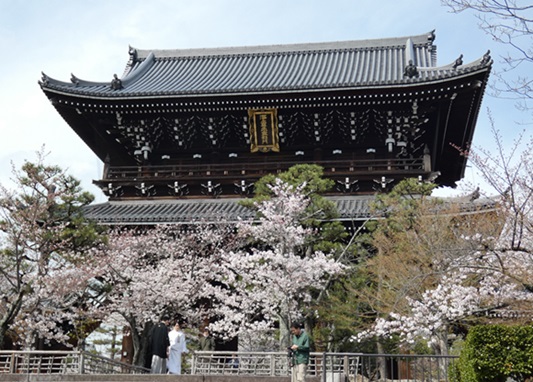
The large, two story ceremonial gate at Konkai Komyo-ji Temple
Konkai Komyo-ji Temple is one of eight chief temples in Japan belonging to the Pure Land sect of Buddhism. Not referring to the sites of the temples, the Pure Land lies far beyond the sinking sun and adherents of the sect pray that they might reborn in the Pure Land. This is the largest sect of Japanese Buddhism with 22 million believers. There were not many visitors while we were at Konkai Komyo-ji as this temple is not on the typical tourist trail, but there were several young couples in traditional dress, having photographs taken under the cherry trees.
At this point, we needed to clarify the difference between shrines and temples. The former are generally Shinto and the latter are typically Buddhist but both are often located on the same site, usually starting as a Shinto shrine with a Buddhist temple added later. Shinto was the earlier, endemic religion of Japan with Buddhism gradually arriving from India, via the Silk Road through China and Korea. Officially Buddhism was introduced to Japan in the mid-sixth century (around 550) when King Seong of Baekje (now western South Korea) sent a mission to Emperor Kinmei that included an image of the Buddha, ritual banners, and sutras (writings).
Unlike Western religions which focus on exclusivity, in Japan it is considered acceptable to practice different religious traditions simultaneously. Thus, many people adopt both Shinto and Buddhist rituals and beliefs, these being the by far the most popular religions in Japan. While plenty of Japanese claim no religious affiliation, of those that do about 1% are Christians, 4 - 6% other religions, and at least 70% identify as Shintoists and 67% as Buddhists, with about 40% overlap of these two religions.
Part of the reason for that overlap is that Shinto is often regarded more as a way of life than a religion. Shinto has no single founder or canonical text (both present in Buddhism) and focuses on rituals and adapting to the pragmatic requirements of life rather than doctrine. The doctrine of Buddhism might be summarized as the belief that human life is a cycle of suffering and rebirth, but it is possible to escape this cycle forever, if a transcendent state of enlightenment (nirvana) is achieved.

One of many beautiful buildings in the Konkai Komyo-ji Temple complex
Kami are the objects of Shinto veneration which are spirits and deities that can be of mythological, spiritual, or natural phenomena, including the spirits of venerated dead people, forces of nature, and elements of the landscape, and which can have both good and evil characteristics. "Kannagara" is the way of the Kami, a law of natural order with "wa" being the benign harmony inherent in all things. Disruption of wa is bad whereas contributing to wa, such as subordination of the individual to the larger social unit, is regarded as good.
While humans are regarded in Shinto as fundamentally having purity or "harae", this has to be maintained by the avoidance of pollution by impurity or "kegare". Temporary states of impurity can be reversed by ritual purification and this is incorporated into many aspects of Japanese culture, including the emphasis on bathing. Flowing water is often available for ritual purification on approaching a shrine.
Once we left the Konkai Komyo-ji temple, Kaoru took me to visit her office. Part of the Kyoto University campus is literally just around the corner from her condo and her office is just a few hundred yards inside the campus boundary. Kyoto University is a national research university with law and medical schools, that was founded 1897, making it the second oldest university in Japan after Gakushūin University, a private college in Tokyo. Kyoto University has around 22,500 students and an 11% acceptance rate which compares with a total enrollment of almost 61,000 and 23% acceptance rate at the University of Florida.
That evening, we had dinner at a tiny local restaurant that Kaoru had booked for us. A reservation was essential as there were just two tables each with low stools for four, and some taller stools at a bar. We let Kaoru order the house special menu of tempura vegetables and shrimp, along with many small side dishes, including some very delicate and fancy carvings of vegetables.

Vegetable side-dish: sweet-potato on right is carved and stained to look like a pinnate leaf; items on the left were intricately carved potatoes as a lantern and a dragon - it seemed a shame to eat such works of art
After a good night's sleep on the comfortable futon in the condo, we were ready for our second day of Japanese culture...specifically more temples and interesting food. The starting point was a visit to Kyoto's temple that is most popular with tourists, Kiyomizu-dera Temple, a UNESCO World Heritage Site. We tried to beat the crowds but it was already busy by the time we got there, as many people were attracted, like us, to the description that it appears to float in the cherry blossoms and trees.
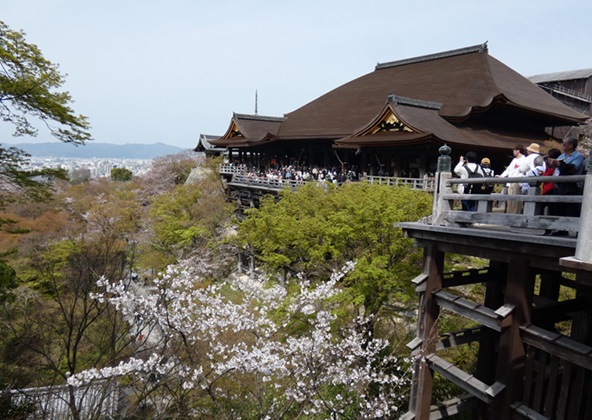
The main hall of Kiyomizu-dera Temple, appearing to float above the trees with the city of Kyoto in the distance
Like many of the old temples in Kyoto, Kiyomizu-dera is on the edge of the city with wooded hillside owned by the Temple behind it. These steep hillsides are protected so that views of the temples with woodlands behind them are not spoiled.

Wooded hillside with blooming cherry trees, uphill from Kiyomizu-dera Temple
Belonging to the Buddhist Kita-Hosso sect, the Kiyomizu-dera temple is located on the foothills of Mount Otowa, in the Higashiyama Mountain range that borders eastern Kyoto. The temple was founded in 778 AD (16 years before the city became the capital of Japan) when a Buddhist priest from the nearby capital city, Nara, claimed to have a vision that directed him to the site of Otowa Spring. This spring gave rise to the temple's name which means "Pure Water Monastery".
The spring still flows and is divided into three streams, each of which is associated with a particular type of good fortune: health, longevity, and exam success. Many visitors choose to sample the water because of these supposed magical properties although it is considered greedy to sample more than one stream. Thus, the appropriate stream should be chosen for the desired type of good luck.

Visitors sampling water from the three branches of the spring at Kiyomizu-dera Temple
Many of the buildings and pagodas at Kiyomizu-dera Temple are painted orange, or more appropriately "saffron". This is a significant color in Buddhism indicating illumination or the highest state of perfection and many monks wear saffron robes.

Okunu-in Hall at Kiyomizu-dera Temple with statue of Buddha inside
The bright paintwork suggested recent renovations, and we found a few dougongs that had yet to be restored. Rather than effigies of the manatee-like marine mammal found around Australia and the Southwestern Pacific (dugongs), dougongs are a structural element in traditional, timber-framed Chinese architecture. With layers of interlocking wooden brackets, they form a stable connection and vertical transfer of weight between the larger surface of a horizontal beam and the top of a column. One of the earliest examples of modern mortise and tenon joints, using precisely cut notches and grooves to allow for a tight fit, dougongs reduce the strain on horizontal beams and provide elasticity which allows buildings to withstand earthquakes better. As seen here, many layers of blocks may be included along with highly ornate painting.

Example of restored and non-restored dougongs on Okunu-in Hall
The two most eye-catching saffron buildings in the temple complex are the three-story pagodas. Common to Southeast Asia, pagodas are tiered towers with multiple eaves. Typically Buddhist, they were derived from stupas, which were dome-shaped buildings used for meditation and to store relics in ancient India. Although the oldest and tallest pagodas were typically made of wood, they were susceptible to lightning strikes and other sources of fire, so many of the oldest surviving pagodas are made of brick or stone.

Koyasunoto Pagoda, one of the three-story pagodas at Kiyomizu-dera Temple
While often used to protect and preserve Buddhist relics and artifacts, pagodas are auspicious symbols of the path to heightened awareness and perception. According to one source, the Koyasunoto Pagoda which is separated from the main temple complex, is dedicated to Koyasu Kannon, a goddess who grants safe delivery of children, so it is often visited by pregnant women.

Randall's picture of the Koyasunoto pagoda with cherry blossoms
The temple's other pagoda, Sanjunoto Pagoda, is part of the main complex of buildings and at 31 m (102 feet) is one of the tallest of such structures in Japan. It was added to the site in 1633, during the Kiyomizu-dera reconstruction three years after a massive fire destroyed the temples and main hall.

Looking north from the Koyasunoto pagoda to the main Kiyomizu-dera Temple complex with the Sanjunoto Pagoda on the left and the main hall and stage (Butai) on the right
The original main hall, which was reassembled from an emperor's palace, was added to the temple in 798, a few years after Emperor Kammu moved the nation's capital from Nara. Rebuilt in 1633, the main hall and its wide veranda, or Butai, is perched over a steep cliff. Huge tree trunks were used as support posts and not a single nail was used in the construction of the entire structure. Such large halls and verandas were added to many popular sites during the Edo period (1606 to 1868) to accommodate large numbers of pilgrims. This platform has a floor of 410 cypress board supported by 168 pillars of 12-m (40 feet) tall keyaki (Japanese Zelkova a native tree often used for bonsai). Reassuringly, these posts were restored in 2017.
This Butai is referenced in the popular Japanese expression "to jump off the stage at Kiyomizu" which equates to the English "to take the plunge". This refers to an Edo-period tradition that suggested that if one were to survive the 13-m (43-foot) jump from the stage either (depending upon the source) one's wish would be granted, or as a monk one would gain spiritual merit. Of the 234 jumps recorded an astonishing 85% survived (perhaps saved by the trees below), but in 1872 the potentially suicidal practice was prohibited.
Despite the crowds, we enjoyed a lovely morning completing a loop of the temple complex before returning to the car via the narrow approach street which is famous for ceramics. The small stores had windows full of fine china...and signs saying No Photographs! We also passed several stores renting out kimonos and yukatas. These are very popular at this time of year for young adults or tourists to have their photographs taken with the cherry blossoms. Kaoru explained how she can tell from a distance if young women in kimonos are Japanese or other Asians. Japanese women intuitively know to take small steps, while Koreans, for example, will try to walk normally and find the kimono very constricting of their paces.

Two young women, probably tourists in rented kimonos, striding in a rather un-traditional manner up the street toward the Kiyomizu-dera Temple
After lunch we left Joe at the condo, while Kaoru, Randall and I walked east to Ginkaku-ji Temple (Temple of the Silver Pavilion) another UNESCO World Heritage site. Two of the main features of this site are the Silver Pavilion and the Zen Garden including precisely raked and shaped areas of coarse white sand. Unsurprisingly, there are many signs asking visitors "Please do NOT touch - Ginsyadan sand layer".

The sand garden at Ginkaku-ji with the carefully formed pile said to symbolize Mount Fuji, a.k.a. Kogetsudai (Moon-Viewing Mound) and Ginshadan (Sea of Silver Sand) in front of the Silver Pavilion
Plans for a retirement villa and gardens were initiated in 1460 by Shogun Ashikaga Yoshimasa. It was similar to the design of the golden pavilion, Kinkaku-ji (in northwestern Kyoto), which had been commissioned by the Shogun's grandfather. It is alleged that it was planned for this pavilion to be covered with silver foil, but this is unlikely since the popular nickname dates from a later period.
Ashikaga Yoshimasa became a Zen Buddhist monk in 1485, acquiring the name Jisho-ji. After his death in 1490, the villa and gardens became a Buddhist temple complex and was also renamed Jisho-ji. The temple is today associated with the Shokoku-ji branch of Rinzai Zen and just over 5 million Japanese identify themselves as Zen Buddhists.

Moss-covered garden within the Ginkaku-ji Temple complex - Kaoru spotted several small ardisia (coralberry) plants scattered through the area (an invasive species in Florida on which we have both conducted research)
Now for a few words on emperors and shoguns.
Mythology suggests that the first Japanese emperor, Emperor Jimmu, was a descendant of the Shinto Sun Goddess Amaterasu, and was enthroned in the year 660 BC. Modern research suggests that verifiable emperors did not appear until 539 AD with Emperor Kinmei. The duties as an emperor, and thus head priest of the Shinto religion, are passed only to male children. With a line of about 100 emperors, the Japanese Imperial House is the oldest continuous hereditary monarchy (lifetime heads of state) in the world. The Japanese Emperor is also the world's only remaining head of state with the title of emperor. The powers of these emperors have varied over time between actual imperial rulers and a largely symbolic, ceremonial role. The current Constitution of Japan defines the emperor as "the symbol of the State and of the unity of the people".
Shogun, by contrast, was the title of the military ruler of Japan during most of the period spanning from 1185 to 1868. Nominally appointed by an Emperor, the shogun was usually the de facto ruler of the country although their relative roles strengthened and weakened many times. The office of shogun was hereditary, but over the course of the history of Japan, several different clans held the position. While emperors lived in their Imperial Palaces in the nation's capital, shoguns might have had castles in the capital but often lived or moved around elsewhere in Japan depending upon military advantage. Although the current head of Japanese government is titled Prime Minister, a retired prime minister who still has power and influence behind the scenes may be referred to as a "shadow shogun".

View over Giinkaku-ji Temple towards Kyoto - Kaoru and Joe's apartment is just to the right of the wooded hill in the middle distance
We enjoyed walking around the gardens where much of the ground was covered with a variety of mosses. We also followed a trail to a freshwater spring and up to view point looking west over the city. Once we had left the Ginkaku-ji complex, Randall and Kaoru walked home while I waited outside the temple at the north end of the Philosopher's Walk. Here I was due to meet Jennie and her three daughters, Sarah, Josie (my goddaughter who now lives in Melbourne, Australia), and Claire, who, apart from Josie, were visiting from near London, UK.

Meeting under the cherry blossoms: L to R - Jennie, Claire, Josie and Sarah
Running a little late (this was not entirely surprising...), they had caught a taxi rather than waiting for the bus from Arashiyama, where they had been excited to see and feed Japanese macaques. Within the Monkey Park, the humans are kept in cages and hold appropriate food through the bars to feed the wild monkeys.
Once reunited, we enjoyed the impressive cherry blossoms along the Philosopher's Walk and associated irrigation canal that carries water from the large freshwater lake in the neighboring mountains, Lake Biwa. The Walk, first opened in 1890 and extended in 1912, was named because two 20th-century Japanese philosophers and Kyoto University professors were thought to have used it for daily exercise.

More cherry blossoms along the Philosopher's Walk
At the end of the Walk, Sara, Josie, and Claire took a bus back to their rented apartment while Jennie and I continued walking past the massive Sammon Gate of the Nanzen-ji temple and through Maruyama Park. This park has many cherry trees and huge numbers of people were having picnics underneath or having photos taken of themselves dressed in kimonos and yukatas.

Young Japanese people dressed in traditional kimonos and yukatas and posing for photographs under cherry trees in Maruyama Park
Yakking the whole way, Jennie and I then headed south along the bank of the Kamo River to finally cut west to their apartment. A short walk early in the evening brought us to a restaurant at the main railway station where Kaoru had booked a table, knowing that it would be close to their apartment. Amazingly, we got there precisely on time and it was Kaoru, Joe, and Randall who were late, having been delayed by traffic.

Us, Kaoru and Joe, Jennie's family, and her random new Japanese friends as we are about to say farewell after dinner
We had a wonderful meal with Kaoru ordering a wide selection of mostly vegetarian dishes for everyone to try. It was great fun as I sat with Sarah, Josie, and Claire and Jennie had a chance to ask Kaoru plenty of questions about Japan. We were only sorry that Jennie and the girls would be leaving for Osaka the next day so they could not spend more time with us and our wonderful hosts. Just before we were about to leave, in her marvelously friendly way, Jennie struck up a conversation about sustainability and reducing disposable waste in hospitals, etc., with a local young woman who was there with her mother. They were both excited about the prospect of communicating on this topic further. Jennie has clearly not understood the concept of retirement at all!
It all made a chaotic and amusing leave-taking as we said goodbye multiple times to Jennie's family and headed our separate ways again. Our plan for the next day was to visit Nara and learn about the capital of Japan before Kyoto and Tokyo.
Our more than 13-hour daytime flight from Toronto to Tokyo gave us plenty of opportunities to enjoy the airline's movies (including happily watching Barbie for a second time). We also had some spectacular views as we flew over northern Canada and the North Slope Basin of Alaksa. Flying over the Bering Strait, we crossed the International Dateline, cutting short Tuesday (2nd April) and thrusting us well into Wednesday.

Flying over the North Slope Basin of Alaska
We landed about on time at Haneda Airport in Tokyo, but there was a significant delay before we could leave the plane. After a long walk we reached the Arrivals Hall to find absolute chaos, not what we had expected in Japan at all. Initially there was no apparent line to reach the immigration desks, but after following the slow shuffle of the crowd from several incoming flights, we found ourselves in a long, long, single-file line, weaving back and forth across the hall.
When we eventually reached the Immigration desk, we were checked in quickly and efficiently. However, we already knew that we had little chance of making our connection. Collecting our bags we approached the Customs officer and x-ray machine anticipating a long explanation. Instead, we were waved straight through. Thankful that the process was not as complicated as I had feared, it had taken us over two hours to get through the arrival procedures, and we still had to re-check our bags and take a bus to another terminal to get our 6 pm flight to Osaka.
We had plenty of company with other exhausted travelers as we queued at the "All Nippon Airways" re-check desk but amazingly, the ANA representative was able to find us seats on their 7:15 pm flight. The shuttle bus delivered us to the correct terminal, the line at security was surprisingly small, and we made it to the gate of our revised flight with a few minutes to spare. We both napped soundly on the 70-minute flight knowing that in the dark we would not get to see Mount Fuji as Jennie and her daughters had done on their train ride from Tokyo to Kyoto a few days earlier.

Jennie's photo of Mount Fuji seen from the train from Tokyo to Kyoto (alas, it was dark when we flew past)
Things were looking promising but by the time we got our luggage at Osaka Airport, the last bus to Kyoto had already left. We had no energy left to work out the train schedule or drag our luggage through the necessary changes. Talking to Kaoru, she suggested that we could take a taxi all the way from Osaka to her condo but it would have been expensive and tiring. Instead, we were able to get a tiny but neat room in the Osaka Airport hotel where we quickly showered and collapsed into bed. We were sorry to miss a night with our marvelous hosts Kaoru and Joe, but we were probably better company once we were rested than if we had arrived totally exhausted.

Our excellent and generous hosts, Joe and Kaoru
We caught the 8:20 am bus to Kyoto after a good breakfast in Le Pan café of the airport (complete with boiled eggs from which the top was neatly removed by a Eierschalensollbruchstellenverursacher (see https://en.wiktionary.org/wiki/Eierschalensollbruchstellenverursacher where the lower ball is lifted up and dropped a couple of times...it sometimes does not take much to impress us). Kaoru kindly met us in her car and drove us through the city to her condo. Here, we were fascinated by the parking garage.

Kaoru backing her car into the parking garage below her condo
We were initially confused when Kaoru said that there were nine pens for eight cars (one space is empty to allow the eight pens to be moved around), but there are three pens below the ground level that cannot be seen in this photo. The driver requests which pen is to be vacated/filled and the machine finds the best way to shuffle the pens and the single space to get the required car to the exit/entry position shown at the left. This may not be unusual to big city residents but was new to us...as I said, it often does not take much to impress us. Land space is obviously of great value in most of Japan and public transportation is highly developed and well-used.
Spread over 3,000 km (almost 1,900 miles) along the Pacific coast of continental Asia, the five main islands of Japan, Hokkaido, Honshu, Kyushu, Shikoku, and Okinawa, plus another 14,120 "remote islands", form a total land area of 364,546 km2 (140,752 sq mi). This a about 1.5 times the land area of Great Britain and slightly smaller than California. With a population of just over 125 million, Japan is much more densely populated than Britain (67 million) and California (39 million).
Since most of the land is ruggedly mountainous and 66% is covered with forest, the population is concentrated around the coast, mostly in large cities. Only 20% of the land area is suitable for agriculture, which is highly intensive and fills most of the non-mountainous, non-urban areas. Agriculture only accounts for about 1% of the nation's gross domestic product. Industry contributes almost 30% of GPD while almost 70% is provided by the service sector including a large proportion related to international trade to provide natural resources to support industry. Kyoto is not highly industrialized, but does have the headquarters of the well-known video gaming company, Nintendo.

In urban areas, some intensively managed, small-scale farming or gardening plots remain
Located on the Pacific Ring of Fire, Japan is prone to frequent earthquakes, tsunamis, and volcanic activity as the Pacific tectonic plate subducts beneath the continental North American plate and the latter collides with the Eurasian plate. Although also prone to typhoons, the risk of earthquakes is probably why most utility wiring is kept above ground, rather than protected from wind in hard-to-repair underground ducts. Through-roads, in Kyoto are wide but most of the local streets seemed to be quite narrow and apartments blocks and houses were crowded together with minimal yards or gardens.

A very busy tourist road (leading to a popular temple) typical of narrow, local streets with a profusion of utility wires between poles overhead
Japanese life appears to be a fascinating mixture of traditional and highly modern practices. In a dense population, discretion and cleanliness are highly valued. Removal of shoes on entry to homes or anywhere with a raised floor, e.g., in traditional restaurants or hotels, is common. It does not take long to notice the high complexity of many Japanese toilets both public and private. Options for various types of bidets, some with driers, and water-sounds or music to cover "bodily noises", can make a trip to the bathroom quite an adventure. The fondness of many for electronics and gimmicks can result in some interesting experiences, such as a hotel with a self-check-in desk that is overseen by motion-activated dinosaur robot "hosts".

Guests are expected to check themselves in on computer terminals while these animatronic dinosaurs move and roar in the background
To aid visitors, most directions on streets, in airports, and in train stations are given in English versions as well as Japanese characters. Of course, Google Maps in the user's own language simplifies travel enormously. While Google Translate can be useful, especially for reading labels, many people in Kyoto speak some English. The occupation of Japan by Allied forces between 1945 and 1952, probably contributed to the integration of English into many Japanese activities. Of course, we were so well looked after by Kaoru, that Randall and I hardly needed to worry about trying to communicate in Japanese or understand signs. Traveling on their own in Tokyo and then getting to Kyoto and Osaka, Jennie and her daughters were much more adventurous in that regard than we were.
As mentioned before, the coincidence of their visit with ours was largely because we were all trying to catch the cherry blossom season in Kyoto. Given the warm winter, Kaoru had suggested that the season may have been over in Kyoto by early April and so had booked us for a night in a hotel in Yoshino. This small town is south of Kyoto but high enough in the Kii Mountains that its thousands of cherry trees bloom significantly later than in the city.

Cherry blossoms in Kyoto showing buds and variations in flower color
However, March was unusually cold, which delayed the cherry blossoms in Kyoto. So, to our great delight, the peak of blooming was exactly when we were there...we were SO LUCKY! We could see the blossoms thicken on the trees for the first few days of our visit, and peaking just before we left, some wind and rain scattered many of the petals in white carpets on the ground. Kyoto has many cherry trees planted along roads, waterways, around important buildings, and growing wild on the hillsides. As we looked at a cherry tree on the side of the wooded hill across the street from Kaoru and Joe's condo, it started a real obsession with the blossoms wherever we went.

A cherry tree densely covered in bright white blossoms
Unlike Jennie and her daughters, we did not spend any time visiting the nation's current capital city, Tokyo, but concentrated our short stay in Japan in Kyoto. Both near the coast of Japan's largest island of Honshu, Tokyo is east, but not much further north, than Kyoto. The city of Kyoto has a population of 1.46 million and the Greater Kyoto metro area had about 3.8 million inhabitants. This is considerably smaller than the metropolitan area of Tokyo with over 37 million residents.
Archeological evidence suggests that the area of Kyoto was settled in the Paleolithic period, prior to 12,000 years ago. However, little has been recorded of human activity in the region prior to the 6th century. The growing community had various names until it became the site of the imperial court, or capital of Japan in 794 AD when it became widely known as Kyoto or "capital city". When established as the capital the expanding city was planned on a grid system according to traditional Chinese feng shui principles, following the models of two ancient Chinese capitals. The seat of the emperor was moved to the city of Edo in 1868, at which time, that city became known as Tokyo "eastern capital". Given its importance from 794 to 1868, Kyoto is sometime referred to as the thousand-year capital.
Considered the cultural capital of Japan, Kyoto was spared from large-scale bombing and destruction during World War II. With more than 1,600 Buddhist temples, 400 Shinto shrines, palaces, and gardens, 14 of which are designated collectively as the Historic Monuments of Ancient Kyoto UNESCO World Heritage Site, Kyoto is a popular tourist destination. Like us, many tourists timed their visits to coincide with the cherry blossoms.
After dropping off our bags, viewing their condo, and meeting Pia the cat,
Kaoru and Joe took us into the city to the Nishiki Market. Cold groundwater in this area was used to keep fish and meats fresh in an area close to the Kyoto Imperial Palace, with the sale of fish starting as early as 782. An official market was established in 1615 and this has continued to the present day.

Inside the Nishiki Market with many small stalls specializing in particular kinds of food
Known as "Kyoto's kitchen" and popular with tourists, there are about 130 small shops in the Nishiki Market selling food items such as fish, fruit, vegetables, tofu, and dry foods, many of which are ready to eat. Most stores specialize in particular types of food and these include many items not commonly seen outside Japan. We were intrigued by the half-shell sea urchins and fish-on-a-stick, and slightly horrified by the sparrows-on-a-stick. Instead of trying any of these, we bought a bag of lovely roasted chestnuts.

Typical store in Nishiki market with fish on a stick (center front) and sparrows on a stick to their right
We had lunch at a small restaurant nearby, most of us selecting a boiled cod soup while Randall was more adventurous with a tray of small dishes, pickled vegetables, meats, etc., served with a bowl of rice, a very popular style of eating in Japan. Afterwards we stopped at the Konkai Komyo-ji Temple not very far south of Kaoru and Joe's condo. Founded in 1175, this Buddhist temple was destroyed by war or fire but subsequently rebuilt several times. The colossal two-story ceremonial gate at the entrance to the temple complex was built in 1860, and leads to many buildings, a cemetery, ponds, and gardens. We soon came to recognize that multiple, curved roofs are a common feature of Japanese temples.

The large, two story ceremonial gate at Konkai Komyo-ji Temple
Konkai Komyo-ji Temple is one of eight chief temples in Japan belonging to the Pure Land sect of Buddhism. Not referring to the sites of the temples, the Pure Land lies far beyond the sinking sun and adherents of the sect pray that they might reborn in the Pure Land. This is the largest sect of Japanese Buddhism with 22 million believers. There were not many visitors while we were at Konkai Komyo-ji as this temple is not on the typical tourist trail, but there were several young couples in traditional dress, having photographs taken under the cherry trees.
At this point, we needed to clarify the difference between shrines and temples. The former are generally Shinto and the latter are typically Buddhist but both are often located on the same site, usually starting as a Shinto shrine with a Buddhist temple added later. Shinto was the earlier, endemic religion of Japan with Buddhism gradually arriving from India, via the Silk Road through China and Korea. Officially Buddhism was introduced to Japan in the mid-sixth century (around 550) when King Seong of Baekje (now western South Korea) sent a mission to Emperor Kinmei that included an image of the Buddha, ritual banners, and sutras (writings).
Unlike Western religions which focus on exclusivity, in Japan it is considered acceptable to practice different religious traditions simultaneously. Thus, many people adopt both Shinto and Buddhist rituals and beliefs, these being the by far the most popular religions in Japan. While plenty of Japanese claim no religious affiliation, of those that do about 1% are Christians, 4 - 6% other religions, and at least 70% identify as Shintoists and 67% as Buddhists, with about 40% overlap of these two religions.
Part of the reason for that overlap is that Shinto is often regarded more as a way of life than a religion. Shinto has no single founder or canonical text (both present in Buddhism) and focuses on rituals and adapting to the pragmatic requirements of life rather than doctrine. The doctrine of Buddhism might be summarized as the belief that human life is a cycle of suffering and rebirth, but it is possible to escape this cycle forever, if a transcendent state of enlightenment (nirvana) is achieved.

One of many beautiful buildings in the Konkai Komyo-ji Temple complex
Kami are the objects of Shinto veneration which are spirits and deities that can be of mythological, spiritual, or natural phenomena, including the spirits of venerated dead people, forces of nature, and elements of the landscape, and which can have both good and evil characteristics. "Kannagara" is the way of the Kami, a law of natural order with "wa" being the benign harmony inherent in all things. Disruption of wa is bad whereas contributing to wa, such as subordination of the individual to the larger social unit, is regarded as good.
While humans are regarded in Shinto as fundamentally having purity or "harae", this has to be maintained by the avoidance of pollution by impurity or "kegare". Temporary states of impurity can be reversed by ritual purification and this is incorporated into many aspects of Japanese culture, including the emphasis on bathing. Flowing water is often available for ritual purification on approaching a shrine.
Once we left the Konkai Komyo-ji temple, Kaoru took me to visit her office. Part of the Kyoto University campus is literally just around the corner from her condo and her office is just a few hundred yards inside the campus boundary. Kyoto University is a national research university with law and medical schools, that was founded 1897, making it the second oldest university in Japan after Gakushūin University, a private college in Tokyo. Kyoto University has around 22,500 students and an 11% acceptance rate which compares with a total enrollment of almost 61,000 and 23% acceptance rate at the University of Florida.
That evening, we had dinner at a tiny local restaurant that Kaoru had booked for us. A reservation was essential as there were just two tables each with low stools for four, and some taller stools at a bar. We let Kaoru order the house special menu of tempura vegetables and shrimp, along with many small side dishes, including some very delicate and fancy carvings of vegetables.

Vegetable side-dish: sweet-potato on right is carved and stained to look like a pinnate leaf; items on the left were intricately carved potatoes as a lantern and a dragon - it seemed a shame to eat such works of art
After a good night's sleep on the comfortable futon in the condo, we were ready for our second day of Japanese culture...specifically more temples and interesting food. The starting point was a visit to Kyoto's temple that is most popular with tourists, Kiyomizu-dera Temple, a UNESCO World Heritage Site. We tried to beat the crowds but it was already busy by the time we got there, as many people were attracted, like us, to the description that it appears to float in the cherry blossoms and trees.

The main hall of Kiyomizu-dera Temple, appearing to float above the trees with the city of Kyoto in the distance
Like many of the old temples in Kyoto, Kiyomizu-dera is on the edge of the city with wooded hillside owned by the Temple behind it. These steep hillsides are protected so that views of the temples with woodlands behind them are not spoiled.

Wooded hillside with blooming cherry trees, uphill from Kiyomizu-dera Temple
Belonging to the Buddhist Kita-Hosso sect, the Kiyomizu-dera temple is located on the foothills of Mount Otowa, in the Higashiyama Mountain range that borders eastern Kyoto. The temple was founded in 778 AD (16 years before the city became the capital of Japan) when a Buddhist priest from the nearby capital city, Nara, claimed to have a vision that directed him to the site of Otowa Spring. This spring gave rise to the temple's name which means "Pure Water Monastery".
The spring still flows and is divided into three streams, each of which is associated with a particular type of good fortune: health, longevity, and exam success. Many visitors choose to sample the water because of these supposed magical properties although it is considered greedy to sample more than one stream. Thus, the appropriate stream should be chosen for the desired type of good luck.

Visitors sampling water from the three branches of the spring at Kiyomizu-dera Temple
Many of the buildings and pagodas at Kiyomizu-dera Temple are painted orange, or more appropriately "saffron". This is a significant color in Buddhism indicating illumination or the highest state of perfection and many monks wear saffron robes.

Okunu-in Hall at Kiyomizu-dera Temple with statue of Buddha inside
The bright paintwork suggested recent renovations, and we found a few dougongs that had yet to be restored. Rather than effigies of the manatee-like marine mammal found around Australia and the Southwestern Pacific (dugongs), dougongs are a structural element in traditional, timber-framed Chinese architecture. With layers of interlocking wooden brackets, they form a stable connection and vertical transfer of weight between the larger surface of a horizontal beam and the top of a column. One of the earliest examples of modern mortise and tenon joints, using precisely cut notches and grooves to allow for a tight fit, dougongs reduce the strain on horizontal beams and provide elasticity which allows buildings to withstand earthquakes better. As seen here, many layers of blocks may be included along with highly ornate painting.

Example of restored and non-restored dougongs on Okunu-in Hall
The two most eye-catching saffron buildings in the temple complex are the three-story pagodas. Common to Southeast Asia, pagodas are tiered towers with multiple eaves. Typically Buddhist, they were derived from stupas, which were dome-shaped buildings used for meditation and to store relics in ancient India. Although the oldest and tallest pagodas were typically made of wood, they were susceptible to lightning strikes and other sources of fire, so many of the oldest surviving pagodas are made of brick or stone.

Koyasunoto Pagoda, one of the three-story pagodas at Kiyomizu-dera Temple
While often used to protect and preserve Buddhist relics and artifacts, pagodas are auspicious symbols of the path to heightened awareness and perception. According to one source, the Koyasunoto Pagoda which is separated from the main temple complex, is dedicated to Koyasu Kannon, a goddess who grants safe delivery of children, so it is often visited by pregnant women.

Randall's picture of the Koyasunoto pagoda with cherry blossoms
The temple's other pagoda, Sanjunoto Pagoda, is part of the main complex of buildings and at 31 m (102 feet) is one of the tallest of such structures in Japan. It was added to the site in 1633, during the Kiyomizu-dera reconstruction three years after a massive fire destroyed the temples and main hall.

Looking north from the Koyasunoto pagoda to the main Kiyomizu-dera Temple complex with the Sanjunoto Pagoda on the left and the main hall and stage (Butai) on the right
The original main hall, which was reassembled from an emperor's palace, was added to the temple in 798, a few years after Emperor Kammu moved the nation's capital from Nara. Rebuilt in 1633, the main hall and its wide veranda, or Butai, is perched over a steep cliff. Huge tree trunks were used as support posts and not a single nail was used in the construction of the entire structure. Such large halls and verandas were added to many popular sites during the Edo period (1606 to 1868) to accommodate large numbers of pilgrims. This platform has a floor of 410 cypress board supported by 168 pillars of 12-m (40 feet) tall keyaki (Japanese Zelkova a native tree often used for bonsai). Reassuringly, these posts were restored in 2017.
This Butai is referenced in the popular Japanese expression "to jump off the stage at Kiyomizu" which equates to the English "to take the plunge". This refers to an Edo-period tradition that suggested that if one were to survive the 13-m (43-foot) jump from the stage either (depending upon the source) one's wish would be granted, or as a monk one would gain spiritual merit. Of the 234 jumps recorded an astonishing 85% survived (perhaps saved by the trees below), but in 1872 the potentially suicidal practice was prohibited.
Despite the crowds, we enjoyed a lovely morning completing a loop of the temple complex before returning to the car via the narrow approach street which is famous for ceramics. The small stores had windows full of fine china...and signs saying No Photographs! We also passed several stores renting out kimonos and yukatas. These are very popular at this time of year for young adults or tourists to have their photographs taken with the cherry blossoms. Kaoru explained how she can tell from a distance if young women in kimonos are Japanese or other Asians. Japanese women intuitively know to take small steps, while Koreans, for example, will try to walk normally and find the kimono very constricting of their paces.

Two young women, probably tourists in rented kimonos, striding in a rather un-traditional manner up the street toward the Kiyomizu-dera Temple
After lunch we left Joe at the condo, while Kaoru, Randall and I walked east to Ginkaku-ji Temple (Temple of the Silver Pavilion) another UNESCO World Heritage site. Two of the main features of this site are the Silver Pavilion and the Zen Garden including precisely raked and shaped areas of coarse white sand. Unsurprisingly, there are many signs asking visitors "Please do NOT touch - Ginsyadan sand layer".

The sand garden at Ginkaku-ji with the carefully formed pile said to symbolize Mount Fuji, a.k.a. Kogetsudai (Moon-Viewing Mound) and Ginshadan (Sea of Silver Sand) in front of the Silver Pavilion
Plans for a retirement villa and gardens were initiated in 1460 by Shogun Ashikaga Yoshimasa. It was similar to the design of the golden pavilion, Kinkaku-ji (in northwestern Kyoto), which had been commissioned by the Shogun's grandfather. It is alleged that it was planned for this pavilion to be covered with silver foil, but this is unlikely since the popular nickname dates from a later period.
Ashikaga Yoshimasa became a Zen Buddhist monk in 1485, acquiring the name Jisho-ji. After his death in 1490, the villa and gardens became a Buddhist temple complex and was also renamed Jisho-ji. The temple is today associated with the Shokoku-ji branch of Rinzai Zen and just over 5 million Japanese identify themselves as Zen Buddhists.

Moss-covered garden within the Ginkaku-ji Temple complex - Kaoru spotted several small ardisia (coralberry) plants scattered through the area (an invasive species in Florida on which we have both conducted research)
Now for a few words on emperors and shoguns.
Mythology suggests that the first Japanese emperor, Emperor Jimmu, was a descendant of the Shinto Sun Goddess Amaterasu, and was enthroned in the year 660 BC. Modern research suggests that verifiable emperors did not appear until 539 AD with Emperor Kinmei. The duties as an emperor, and thus head priest of the Shinto religion, are passed only to male children. With a line of about 100 emperors, the Japanese Imperial House is the oldest continuous hereditary monarchy (lifetime heads of state) in the world. The Japanese Emperor is also the world's only remaining head of state with the title of emperor. The powers of these emperors have varied over time between actual imperial rulers and a largely symbolic, ceremonial role. The current Constitution of Japan defines the emperor as "the symbol of the State and of the unity of the people".
Shogun, by contrast, was the title of the military ruler of Japan during most of the period spanning from 1185 to 1868. Nominally appointed by an Emperor, the shogun was usually the de facto ruler of the country although their relative roles strengthened and weakened many times. The office of shogun was hereditary, but over the course of the history of Japan, several different clans held the position. While emperors lived in their Imperial Palaces in the nation's capital, shoguns might have had castles in the capital but often lived or moved around elsewhere in Japan depending upon military advantage. Although the current head of Japanese government is titled Prime Minister, a retired prime minister who still has power and influence behind the scenes may be referred to as a "shadow shogun".

View over Giinkaku-ji Temple towards Kyoto - Kaoru and Joe's apartment is just to the right of the wooded hill in the middle distance
We enjoyed walking around the gardens where much of the ground was covered with a variety of mosses. We also followed a trail to a freshwater spring and up to view point looking west over the city. Once we had left the Ginkaku-ji complex, Randall and Kaoru walked home while I waited outside the temple at the north end of the Philosopher's Walk. Here I was due to meet Jennie and her three daughters, Sarah, Josie (my goddaughter who now lives in Melbourne, Australia), and Claire, who, apart from Josie, were visiting from near London, UK.

Meeting under the cherry blossoms: L to R - Jennie, Claire, Josie and Sarah
Running a little late (this was not entirely surprising...), they had caught a taxi rather than waiting for the bus from Arashiyama, where they had been excited to see and feed Japanese macaques. Within the Monkey Park, the humans are kept in cages and hold appropriate food through the bars to feed the wild monkeys.
Once reunited, we enjoyed the impressive cherry blossoms along the Philosopher's Walk and associated irrigation canal that carries water from the large freshwater lake in the neighboring mountains, Lake Biwa. The Walk, first opened in 1890 and extended in 1912, was named because two 20th-century Japanese philosophers and Kyoto University professors were thought to have used it for daily exercise.

More cherry blossoms along the Philosopher's Walk
At the end of the Walk, Sara, Josie, and Claire took a bus back to their rented apartment while Jennie and I continued walking past the massive Sammon Gate of the Nanzen-ji temple and through Maruyama Park. This park has many cherry trees and huge numbers of people were having picnics underneath or having photos taken of themselves dressed in kimonos and yukatas.

Young Japanese people dressed in traditional kimonos and yukatas and posing for photographs under cherry trees in Maruyama Park
Yakking the whole way, Jennie and I then headed south along the bank of the Kamo River to finally cut west to their apartment. A short walk early in the evening brought us to a restaurant at the main railway station where Kaoru had booked a table, knowing that it would be close to their apartment. Amazingly, we got there precisely on time and it was Kaoru, Joe, and Randall who were late, having been delayed by traffic.

Us, Kaoru and Joe, Jennie's family, and her random new Japanese friends as we are about to say farewell after dinner
We had a wonderful meal with Kaoru ordering a wide selection of mostly vegetarian dishes for everyone to try. It was great fun as I sat with Sarah, Josie, and Claire and Jennie had a chance to ask Kaoru plenty of questions about Japan. We were only sorry that Jennie and the girls would be leaving for Osaka the next day so they could not spend more time with us and our wonderful hosts. Just before we were about to leave, in her marvelously friendly way, Jennie struck up a conversation about sustainability and reducing disposable waste in hospitals, etc., with a local young woman who was there with her mother. They were both excited about the prospect of communicating on this topic further. Jennie has clearly not understood the concept of retirement at all!
It all made a chaotic and amusing leave-taking as we said goodbye multiple times to Jennie's family and headed our separate ways again. Our plan for the next day was to visit Nara and learn about the capital of Japan before Kyoto and Tokyo.
Springtime colors in Florida
02 April 2024 | We are in Toronto Airport, Canada: Tregoning is in Mersin Marina, Mersin, Türkiye
Alison Stocker | Photo: A yellow flag flower seen during a stroll through woods in southeast Gainesville
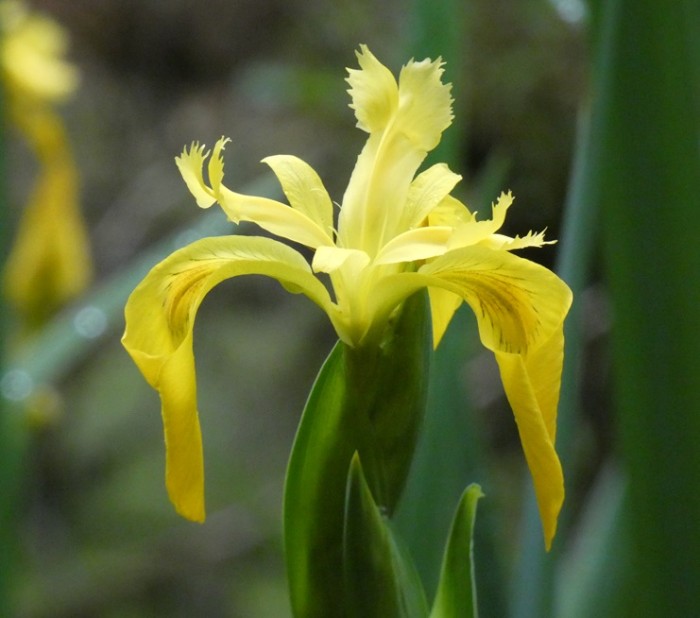
Well, some of my expectations from the last blog post were fulfilled...others not so much.
We had more medical appointments than anticipated. This was largely due to weekly trips to Randall's dermatologist for the removal of various small skin cancers on his face. The last one was the trickiest being on the side of a nostril and, poor fellow, required a skin-graft and week of wearing large dressing and nostril dilators (plastic tubes up his nose). Needless to say, this was not particularly comfortable nor inclining him to feel very sociable. Still, the doctor was pretty pleased with the result so far and we are instructed to send him photos every week for the next month...of the healing site, not of our "vacation".
The inspections of our various other body systems were all encouraging. Randall was particularly delighted to be told that unless he shows relevant symptoms, he need never go through the discomfort of preparing for a colonoscopy again. Lucky him...
We did get a month's break from long-distance traveling, and that was good. However, with so many appointments and various online tasks in preparation for the coming months, spending March in Gainesville did not seem quite as restful as we had hoped. Still, it is a spectacular time to be in north central Florida and Nancy's lovely home was a perfect place from which to watch the explosion of pink azaleas, dazzling white dogwood trees, and the unfolding of vibrant green leaves on the deciduous trees, all of which occurred over a period of just a few days. Against a rich blue sky, this is one of the world's best displays of springtime. Of course, the associated deluge of pollen is phenomenal, leaving a yellow coating on everything left outside, and plaguing the eyes of noses of hay-fever sufferers.
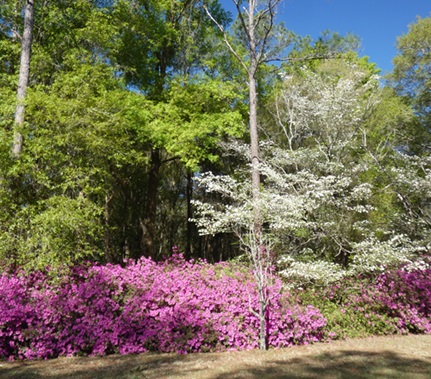
Spring colors in Gainesville: pink azaleas, white dogwoods, and bright green leaves on the deciduous trees
The part of my expectations that seriously fell short was catching up with people that we had not been able to see in November. I managed to squeeze in a few lovely walks, a bit of birding, and delicious meals with some friends in Gainesville, and we spent two nights revisiting Kathy and Dan in Crystal River, but there were many people with whom we failed to connect, partly because it was difficult to plan around the shifting and expanding appointments. We also had to sell our Prius, which made it awkward towards the end, not knowing whether we would have to be available to meet potential buyers. In fact, we had very little interest and were thankful to have a guaranteed purchase by CarMax, even though we almost certainly could have got more money from a private sale had we had more time. Thankfully, Doria and Katie kindly helped provide us with wheels for the days after the car was sold...all part of our complicated dual-continent lives.
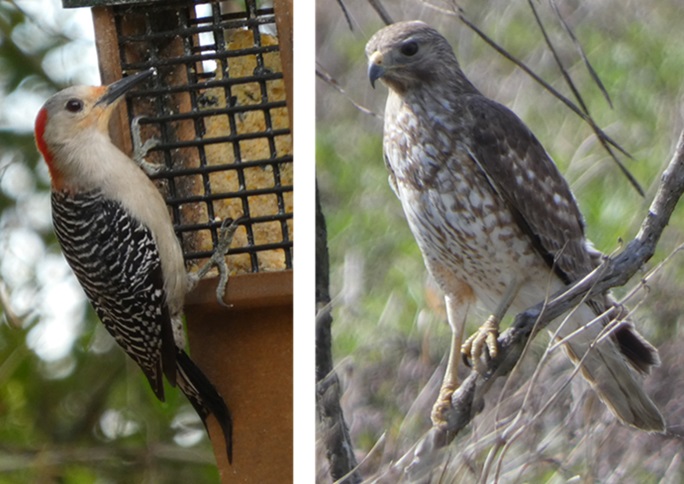
Female red-bellied woodpecker on feeder (to 26 cm or 10 inches: note that the longest tail feathers are used for balance like a third leg) and a juvenile red-shouldered hawk (to 61 cm or 24 inches) in Paynes Prairie
I am writing this as Randall and I are sitting in the international departure lounge at Toronto's Pearson Airport. We left Gainesville yesterday on the RedCoach service, stayed overnight in the Hyatt Regency Hotel at Orlando Airport, and got up soon after 3 am to catch our 6:25 am flight here. We slept most of the way, have a four-hour layover, and then take the 13-hour flight to Tokyo. Assuming that our extra bag with a strange mixture of equipment for the boat does not confuse the Japanese customs officers, we will make our two-hour connection in a different terminal (yikes) to a flight to Osaka, and finally catch a bus from that airport into Kyoto. So far, so good, but it will be a very long and short day for us. A long time before we get to bed at Kaoru and Joe's apartment, and two days (Tuesday and Wednesday) cut short as we cross the international dateline.
We are really thrilled about visiting Japan, particularly as it should be the peak time for cherry blossoms in Kyoto. Neither of us has been to Japan before and although this will be just a short, six-night visit, we very much look forward to seeing some of the beautiful sights and learning a little of Japanese culture. Most especially we are excited about seeing Kaoru and Joe in Kaoru's home country. They have very kindly arranged various activities for our visit including the opportunity to get together with Jennie (visiting from Bushey, London) and her three daughters including Josie visiting from Australia. It will be quite the international gathering, and a fun dose of long-time friends before we move onto Türkiye and reacquainting ourselves with our new friends at Mersin Marina.
We had more medical appointments than anticipated. This was largely due to weekly trips to Randall's dermatologist for the removal of various small skin cancers on his face. The last one was the trickiest being on the side of a nostril and, poor fellow, required a skin-graft and week of wearing large dressing and nostril dilators (plastic tubes up his nose). Needless to say, this was not particularly comfortable nor inclining him to feel very sociable. Still, the doctor was pretty pleased with the result so far and we are instructed to send him photos every week for the next month...of the healing site, not of our "vacation".
The inspections of our various other body systems were all encouraging. Randall was particularly delighted to be told that unless he shows relevant symptoms, he need never go through the discomfort of preparing for a colonoscopy again. Lucky him...
We did get a month's break from long-distance traveling, and that was good. However, with so many appointments and various online tasks in preparation for the coming months, spending March in Gainesville did not seem quite as restful as we had hoped. Still, it is a spectacular time to be in north central Florida and Nancy's lovely home was a perfect place from which to watch the explosion of pink azaleas, dazzling white dogwood trees, and the unfolding of vibrant green leaves on the deciduous trees, all of which occurred over a period of just a few days. Against a rich blue sky, this is one of the world's best displays of springtime. Of course, the associated deluge of pollen is phenomenal, leaving a yellow coating on everything left outside, and plaguing the eyes of noses of hay-fever sufferers.

Spring colors in Gainesville: pink azaleas, white dogwoods, and bright green leaves on the deciduous trees
The part of my expectations that seriously fell short was catching up with people that we had not been able to see in November. I managed to squeeze in a few lovely walks, a bit of birding, and delicious meals with some friends in Gainesville, and we spent two nights revisiting Kathy and Dan in Crystal River, but there were many people with whom we failed to connect, partly because it was difficult to plan around the shifting and expanding appointments. We also had to sell our Prius, which made it awkward towards the end, not knowing whether we would have to be available to meet potential buyers. In fact, we had very little interest and were thankful to have a guaranteed purchase by CarMax, even though we almost certainly could have got more money from a private sale had we had more time. Thankfully, Doria and Katie kindly helped provide us with wheels for the days after the car was sold...all part of our complicated dual-continent lives.

Female red-bellied woodpecker on feeder (to 26 cm or 10 inches: note that the longest tail feathers are used for balance like a third leg) and a juvenile red-shouldered hawk (to 61 cm or 24 inches) in Paynes Prairie
I am writing this as Randall and I are sitting in the international departure lounge at Toronto's Pearson Airport. We left Gainesville yesterday on the RedCoach service, stayed overnight in the Hyatt Regency Hotel at Orlando Airport, and got up soon after 3 am to catch our 6:25 am flight here. We slept most of the way, have a four-hour layover, and then take the 13-hour flight to Tokyo. Assuming that our extra bag with a strange mixture of equipment for the boat does not confuse the Japanese customs officers, we will make our two-hour connection in a different terminal (yikes) to a flight to Osaka, and finally catch a bus from that airport into Kyoto. So far, so good, but it will be a very long and short day for us. A long time before we get to bed at Kaoru and Joe's apartment, and two days (Tuesday and Wednesday) cut short as we cross the international dateline.
We are really thrilled about visiting Japan, particularly as it should be the peak time for cherry blossoms in Kyoto. Neither of us has been to Japan before and although this will be just a short, six-night visit, we very much look forward to seeing some of the beautiful sights and learning a little of Japanese culture. Most especially we are excited about seeing Kaoru and Joe in Kaoru's home country. They have very kindly arranged various activities for our visit including the opportunity to get together with Jennie (visiting from Bushey, London) and her three daughters including Josie visiting from Australia. It will be quite the international gathering, and a fun dose of long-time friends before we move onto Türkiye and reacquainting ourselves with our new friends at Mersin Marina.
Returning eastward
25 February 2024 | We are back in Gainesville, FL: Tregoning is in Mersin Marina, Mersin, Türkiye
Alison Stocker | Photo: Snow-capped Mogollon Mountains in Gila National Forest, New Mexico
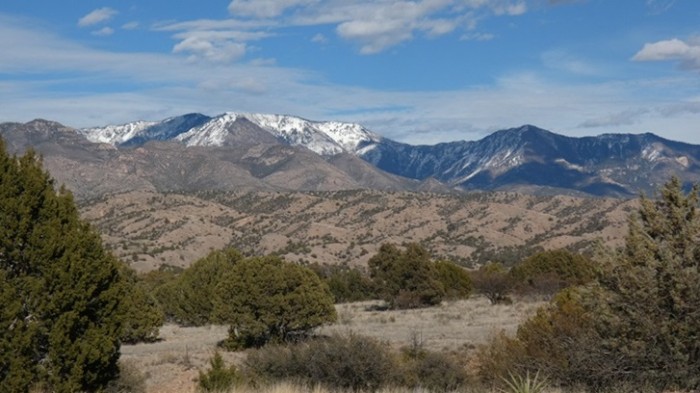
By the time we reached Morro Bay on the evening of Tuesday (12th February), we had only two weeks left before we had to be back in Gainesville. We had to drive the width of the continent and we had many friends and relations still to visit but, in theory at least, it should all be possible if the Prius continued to behave impeccably, and all else went according to plan. Although the weather had improved since we were in San Jose, there were forecasts of another wintery storm system to cross California and potentially follow us eastward. But my more immediate concern was finding sea otters.
After running south along the main street of Morro Bay, on Wednesday morning, I returned along the waterfront looking for my favorite mammals. I saw some across the lagoon among the distant boats but, based on Susan's photograph, I felt sure that I should be able to find some that were closer. Then suddenly I came across the mother lode...literally a group of mothers with pups floating close to shore beside the fishing dock. A small sign on the fence asked people to be quiet because this site was a sea otter nursery and it was so cute to see several mothers floating on their backs with their pups resting or squirming on their tummies. Since I did not have my camera, I returned to the motel hoping that they would still be there when I returned with Randall after showering.

Sea otter nursery by the fishing wharf in Morro Bay with a pile (raft) of otters
Yes! They were still there floating peacefully on this calm morning when were returned. Of course, even though I took plenty of photos and video clips, I could have stayed there watching them for hours. But breakfast called, so we eventually dragged ourselves away, promising to return the following morning for another dose of cuteness.
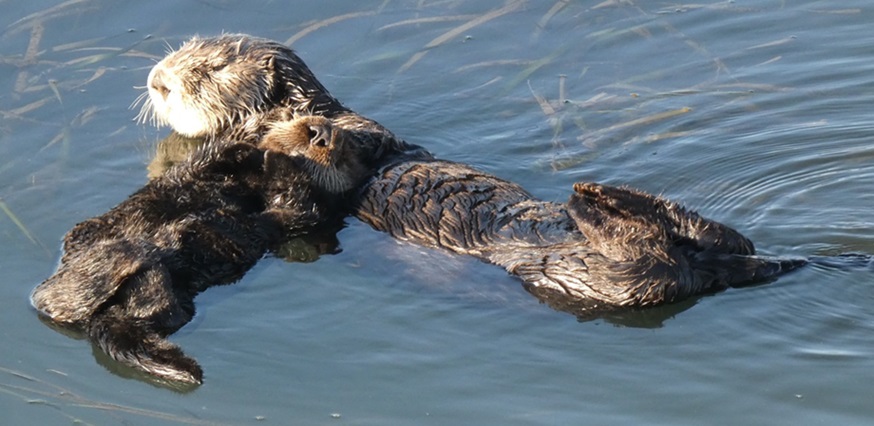
A mother sea otter with her pup resting its head on her chest
Driving inland, we had a delicious lunch with Linda and Randall's cousin Greg at their ranch house made out of straw bales. Plenty of family stories were traded as we ate and watched the birds feeding outside the large windows, including California towhees, curve-billed thrashers, and many California quail. On leaving, we drove through Shandon where we visited the graves of Randall's parents and maternal grandparents. Thanks to the recent rains, the surrounding hills were much greener than they had been on any of my previous visits.
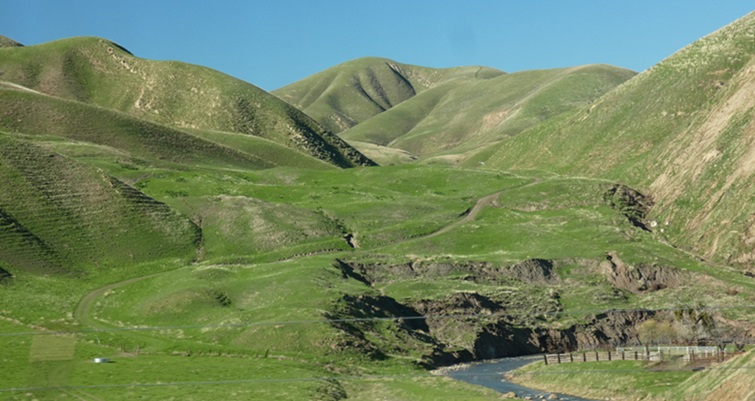
Recent rains had flushed the normally dry hillsides of central California with lush spring grasses, such as these hills in the Diablo Range
On way to Morro Bay from Shandon, we stopped at a nursing facility in Atascadero to visit Randall's cousin Roxanna, who has been seriously ill for the last couple of years. She seemed genuinely touched and happy to see Randall and to meet me. Although her health was poor, her mind was still sharp and many more family stories were exchanged during our very enjoyable conversation. We subsequently heard that she died exactly a week after our visit, making us very thankful that we had been able to see her when we could.
Before leaving Morro Bay on Wednesday, we returned to the sea otter nursery only to find it empty. Empty of otters, that is, there were still sea lions barking on a distant floating dock, common loons, and western `grebes. We continued to Morro Rock at the mouth of the Bay, the northwesternmost of nine named volcanic plugs (although there are actually 23 in total) between San Luis Obispo and Morro Bay. We were hoping to see peregrine falcons on the steep rock face but had to content ourselves with sighting around the Rock of surf scoters, western gulls, bufflehead ducks, and eared grebes. We also saw a few sea otters floating in the kelp beds, not as close to shore as at the nursery, but still a satisfying opportunity to say farewell before we headed further south.
After driving south through San Luis Obispo (where Randall was born) we passed through Santa Barbara (where he got his undergraduate degree at the University of California: Santa Barbara). Looking for former surfing sites of his along the coast, we stopped at Santa Claus Beach, where we walked across the railway tracks to find several long-legged willets wading in the diminutive surf. Given Randall's surfing history in the area, I was intrigued by a sign that said that great white sharks occurred in the area and are protected by state and federal law.

A variation from the warning sign about the predatory dangers of mountain lions seen further north, this sign on a beach near Ventura, CA, is about the protection of great white sharks from people
Arriving at Ventura Marina, we were thrilled to be reunited with Cheryl and Steve, a lovely couple of sailors we had met in Kona, Hawai'i in 2011. We had not seen them for over a decade, but it did not seem that way as we talked about our travels and their amazing global circumnavigation as the support boat with Hokule'a, a Polynesian double-hulled voyaging canoe, sailed and navigated in the tradition ways https://worldwidevoyage.hokulea.com/voyages/our-story/
We had originally intended to stay for the night, but Cheryl was about to have a minor surgical procedure so she was understandably concerned about not catching Covid which would cause this to be postponed. So, we ate outside at a marina restaurant (facing our partners), and then wandered around some nearby ponds looking at the birds. These included gadwall, cinnamon teal, ruddy ducks, mergansers, pied-billed grebes, great blue herons, many black-crowned night herons, and more unusually for the area, a yellow-crowned night heron.
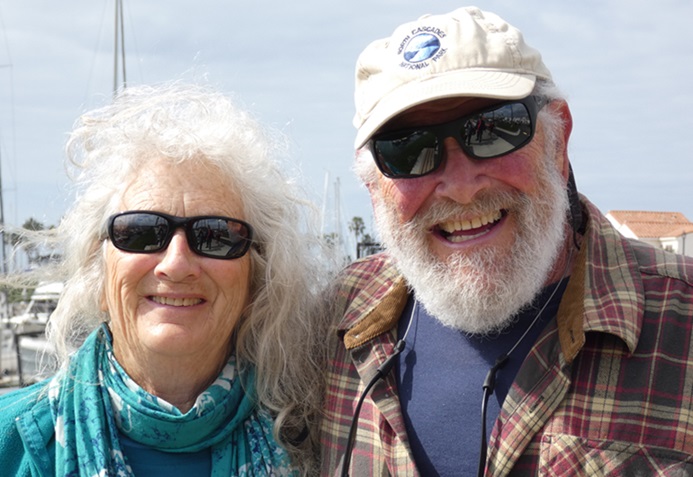
Cheryl and Steve from SV Gershon II at Ventura Marina
(In case you are wondering how I decide of the many people that I mention whose photos to include in the blog, given the nature of the Sailblogs website and its potential for readers who are sailors, I tend more often to include photos of friends we have met cruising.)
On saying goodbye to Cheryl and Steve, we turned eastward, skirting around the north side of Los Angeles. With the afternoon traffic increasing and slowing us down, we finished the day by stopping at motel in Moreno Valley, just east of LA. This afternoon grind reduced the distance to our next motel stop in south Tucson, Arizona, and allowed us time to stop for a couple of hours at the Saguaro West - Tucson Mountain District section of Saguaro National Park. We made a brief stop at the Visitor Center, drove around the Bajada Scenic Loop, and then, as the sun was setting, walked around the Desert Discovery Nature Trail.
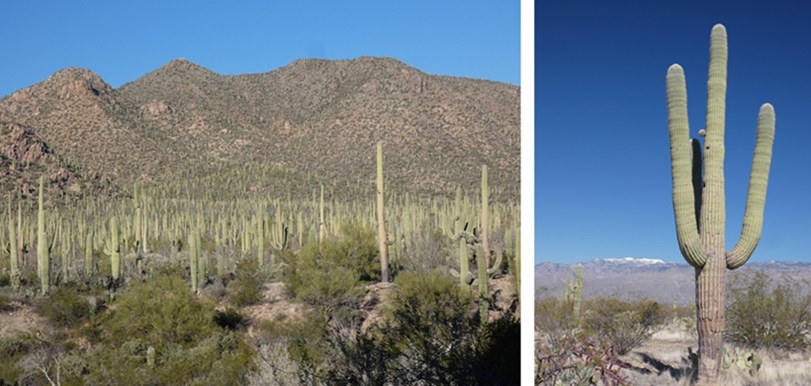
A forest of saguaro cacti and a typically shaped individual in the West Tucson Mountain District of Saguaro National Park
The following morning, we visited the Saguaro East - Rincon Mountain District section of the National Park. We walked along the Freeman Homestead Trail where we did not see a large number of birds, but we did see verdin, phainopepla, curve-billed thrasher, and a gila woodpecker. Many plants looking lusher than usual, such as the bright green leaves of the ocotillo, and there was even a trickle of water in some of the usually dry stream beds. We were sorry not to see or hear cactus- or canyon wrens, but we did hear and not see a new species to us the pyrrhuloxia, a desert-dwelling cardinal. We subsequently followed the Cactus Forest Loop Drive with occasional stops to admire the views of distant snow-capped mountains, adjacent rocky outcrops, or to follow the Desert Ecology Trail.
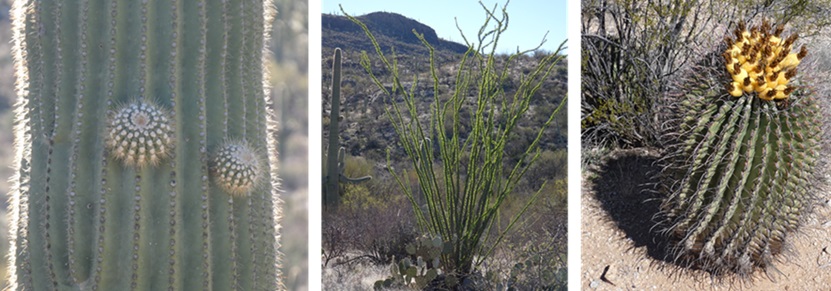
Neophyte branches on a saguaro cactus, an ocotillo that usually looks like a bunch of dead sticks but was covered in bright green leaves after the rains, and a flowering barrel cactus
On our way to the Park, we had passed by an area which appeared to have hundreds of unpainted airplanes packed tightly together. This turned out to be the Historic Aviation Bone Yard, a.k.a. the 309th Aerospace Maintenance and Regeneration Group, which was started at the end of World War II and is now a 2,600-acre (11 km2) facility. With nearly 4,000 miliary and government aircraft, it is the largest aircraft storage and preservation facility in the world, benefitting from a low rate of corrosion in the desert climate. According to Wikipedia, there are four categories of storage for aircraft:
Long Term - aircraft are kept intact in "inviolate" storage for future use with no parts removed; Parts Reclamation - aircraft are picked apart and for spare parts; Flying Hold - aircraft are kept intact with regular running of their engines, lubrication of bearings and servicing of fluids; Excess of DoD needs - aircraft are sold off whole or in parts.
Continuing eastward on Interstate 10, we soon arrived in Willcox, AZ, where we stopped for the night with Randall's cousin, Laurette and her husband Mark. Both flautists and retired school teachers, we wondered if we might get a full concert. That was a bit optimistic but we were very happy to hear Laurette demonstrate her piccolo. Many more family stories were swapped and they asked many, penetrating questions about our aquatic lifestyle...which seemed so distant from their lives surrounded by desert. While we talked, I was excited to watch various birds, including many sparrows and white-winged doves, arrive at their bird feeders. We were especially thrilled to add three new species to our life-lists, the pyrrhuloxia, Gambel's quail, and Bendire's thrasher.

Two new bird species for us at Laurette and Mark's feeders: left - the desert-dwelling cardinal called pyrrhuloxia (to 9 inches or 22 cm) and right - male and female Gambel's quail (to 11 inches or 28 cm)
The following morning, Laurette and Mark drove us to the Crane Observatory by the ponds just south of the Twin Lakes Golf Course. Many of the western populations of sandhill cranes spend the winter in Arizona, New Mexico, and along the Mexican border. We heard a few sandhill cranes on the ground but could not see them unless they were flying overhead. We did see hundreds of American wigeon feeding on the golf course, a trio of snow geese, ruddy ducks, and northern shovelers. It did not take long before Laurette seemed keen to buy a pair of binoculars and start their own birding records.
Having said farewell to Laurette and Mark, we head a little further north, stopping for more birding at Roper Lake State Park. Being the middle of the day, few birds were visible, and there was certainly no sign of the vermillion flycatchers that Randall was keen to see. By a barbecue grill in a campsite, however, we did watch a pair of brown birds that we did not recognize. Happily, we realized that they were Abert's towhees, another new species for us.
Continuing to the northeast, we climbed a twisty road over a low range to arrive in New Mexico at the western edge of the Gila National Forest (pronounced "Hee-la"). Stopping at a viewpoint, we found a plaque to Aldo Leopold (1887-1948) noting that this foresighted forester and wildlife manager had in 1924 established, within the Gila National Forest, the Gila Wilderness - the world's first designated wilderness area. Our northeastward view of the Gila Wilderness included the snow-capped Mogollon Mountains (see introductory photograph). The tallest peak within this range, Whitewater Baldy, is 10,895 ft (3,321 m).
We ended our day's travel in the tiny community of Glenwood in the San Francisco River valley. Somehow Randall had not received the address from our hosts, Roger and Kate, so we had to stop and ask people in the street and at the fish hatchery if they knew Roger. Luckily, it was a small enough community that we were eventually directed to the correct house. Randall and Roger had worked together in Glacier National Park in the 1970s and had not seen each other for several decades. Kate and Roger very kindly allowed us to stay in their newer, hilltop house with a commanding view of the Mogollon Mountains, while they spent the nights in their older house (from which they were slowly moving) down by Whitewater Creek.
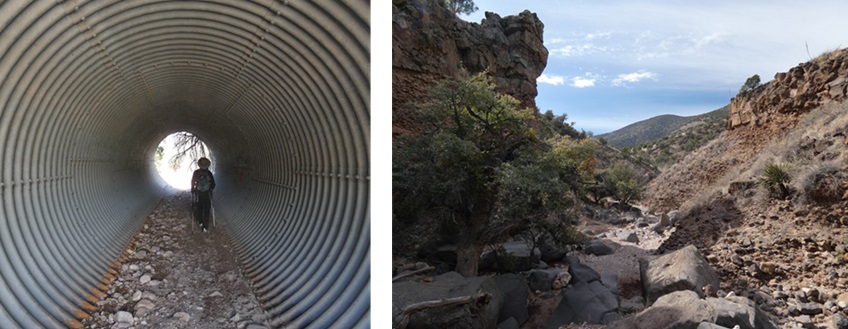
Following Kate into a culvert under the road at the start of our walk in Harve Gulch
On Sunday, while Randall and Roger were happy to sit around exchanging stories about their past activities and mutual friends, Kate and I went hiking with their dog Scout in Harve Gulch. As a young man, Roger had been a researcher of raptors in the Gila Wilderness and many other areas, so he knew the wild mountains and their populations of peregrine falcons intimately. He and Randall had played together in a bluegrass band during their time in Montana, so they had both been keen to get out some guitars and jam. That evening, we were joined by their guitar-playing son Kyle and his young family, for a delightful evening of music.
The following morning, I went running up an unpaved road to a small airstrip, just west of the Catwalk Recreation Area. It was a good workout grinding uphill for over 3 km, but pretty nice coming back down. As I ran, I studied the various pawprints in the recently formed mud. Most were probably dogs, foxes, or bobcats. I was a bit concerned about mountain lions (a.k.a. cougars) although Kate had told me that she had run the same route many times. Although deaths are rarely caused by cougars (27 deaths out of 167 attacks in North America in the last 100 years), biologists surmise that people are more likely to be seen as potential prey when they bend over or squat than when they are standing. Runners who have been stalked by a cougar, may be more likely to be attacked if they bend over to pick something up or tie a shoelace. If I was going to be running in this area regularly, I would buy slip-on shoes...
Later that day, we returned to the nearby Catwalk Recreation Area where Kate led Randall and me up the trail to an impressively robust boardwalk attached to the sides of the narrow Whitewater Canyon. Randall and I both noted that compared to the long boardwalk that we had explored in Homa Canyon in Türkiye in October, the supports and fences for this catwalk, which was replaced after extreme floods in 2013, seemed much more solid. Although Kate and I were keen to follow the trail further up the canyon, part of it was submerged under icy cold water. Lacking waterproof footwear, we reluctantly turned around. This was a pity as we would have seen the type of areas where Roger (as a young man) had repelled down cliffs to study peregrine falcon nests.
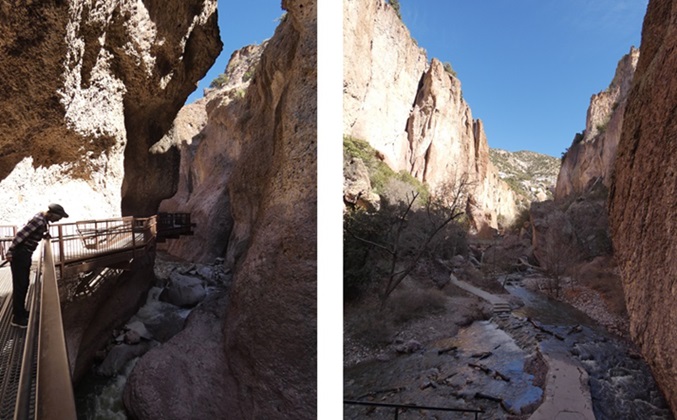
Kate peering down to the creek in Whitewater Canyon below the catwalk on the Catwalk National Recreation Trail: as a result of the recent rains, following the trail further up the canyon would mean wading through cold water
In the afternoon, we drove a little south of Glenwood to the property, in the floodplain of the San Francico River, where Kyle and his wife Meggie have an organic vegetable farm. Amazingly, in an effort to be sustainable, they are building their house out of home-made adobe bricks and they cultivate the land using horse-drawn equipment rather than tractors. Wondering where they found suitable equipment, the answer, which should have been obvious, was from Amish farmers. That is also where they got their four horses (for excellent pictures see their website at: https://mdexter7.wixsite.com/friscofarm ).

Kyle and Meggie's organic vegetable farm in the floodplain of the San Francisco River which they cultivate using horse-drawn equipment
We left early the next morning, for the long drive to Amarillo, Texas, on a scenic route to Albuquerque through Gila National Forest that Roger had suggested. There were many impressive mesas and cliffs along the route and, as recommended, we stopped at La Ventana Natural Arch in El Malpais National Conservation Area. El Malpais (Spanish for "the badlands") is an extensive area of volcanic features including many layers of lava flow, the oldest dating back about 115,000 years, and the youngest to just 3,900 years ago. Underneath the lava flows, were various layers of sandstone. La Ventana Arch and surrounding bluffs were mostly eroded from Zuni Sandstone which was formed from sand blown across a vast desert to form dunes about 160 million years ago. A thinner sandstone layer near the top was of Dakota Sandstone, laid down about 96 million years ago under the water of the Western Interior Seaway. A series of uplifts and collapses caused massive cracks in the Zuni Sandstone which filled with water. Freeze and thaw cycles would have expanded and contracted those cracks causing fragments to break off and resulting in the 125-feet high, and 165-feet wide arch (38 m by 50 m), the tallest in New Mexico (the Snake Bridge arch is wider).
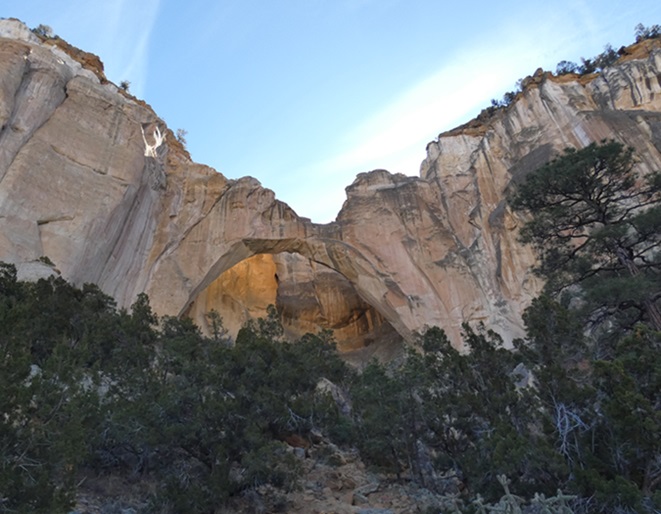
La Ventana Natural Arch - the surrounding cliffs are impressive but sadly one is not allowed close enough to see the sky through the arch
During our long drive across the northern part of Texas to Texarkana, we randomly stopped at the small town of Saint Joseph for lunch at the Chisholm's Chophouse. Arranged in the Spanish style with a large central square, there were several preserved buildings around it, including the Stonewall Saloon, established in 1873 and named for General "Stonewall" Jackson. The town's first permanent building, it had been a saloon and trail drivers' rest stop from days between 1867 to 1884 when cattle were driven from San Antonio, Texas, along the nearby Chisholm Trail, to railheads in Abilene, Kansas. After county prohibition in 1897, the building became offices and a bank.
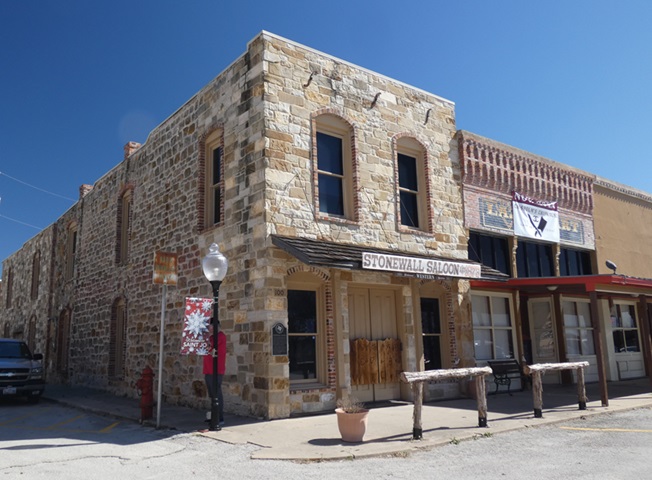
The Stonewall Saloon in St Jo with hitching posts outside and the neighboring Chisholm's Chophouse
After our night in Texarkana, we stopped to look for birds in a park in the southern part of town. The flashes of the bright red of northern cardinals and the sky blue of blue jays were becoming much more common as we headed east. We also had a good sighting of a red-headed woodpecker, and new to us, several white-throated sparrows.
We crossed the mighty Mississippi River on Greenville Bridge, then headed south through the small town of Rolling Fork. With roofless buildings, snapped-off trees, and piles of debris, it was still very evident that this town had been badly hit by a big tornado in March 2023. With maximum windspeeds estimated at 195 mph (314 kph), the tornado traveled with an average forward speed of 50 miles per hour (80 km/h) for 59.4 miles (95.6 km), killing 17 people and injuring 165 others. Even a year later, it was a very sobering reminder of a dramatic force of nature.
Meanwhile, the current weather was surprisingly fine. This was surprising because the winter storm that had been forecast to sweep across the nation from the Pacific had, thankfully, stayed to the north of our route. We were lucky because there was plenty of snow on the Sierra Mountains in California. By the end of February, these areas had seen winds over 100 mph (160 kph) and more than 7 feet (nearly 3 m) of snow. So much snow fell in February, that it is anticipated that there would be no widespread drought in California for a couple of years.
We soon arrived at the duck-hunting camp, near Satartia in the Mississippi Delta (floodplain), of our friend Kurt, whose camp partner, Eric, was also visiting. Having all been professional colleagues, in the evening we shared plenty of stories from working on projects or attending conferences. The cabin overlooked former catfish ponds in a tract that Kurt is actively managing to increase biodiversity and, of course, to attract waterfowl. He gave us a grand tour of the property but there were surprisingly few ducks, only a couple of mergansers. There were, however, plenty of redwing blackbirds, northern cardinals, swamp sparrows, and blue jays.
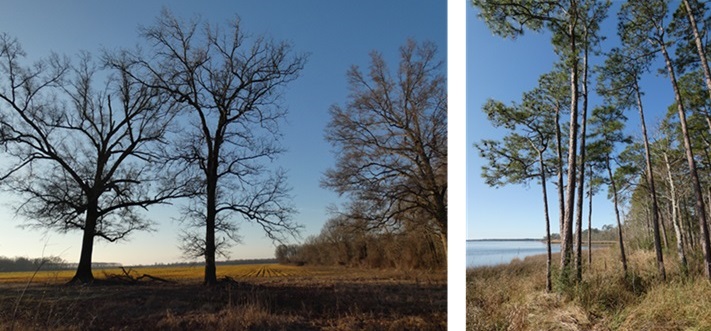
Left - Deciduous trees in Mississippi with Kurt's hunting camp to the right: Right - flatwood pines by Week's Bay National Estuarine Research Reserve, AL, visited with Gidget and Joe
Leaving camp the next morning, we headed southeast, stopping in southern Hattiesburg to eat our picnic and look at the Canada geese, ring-necked ducks, and various other waterfowl at Duncan Lake Park. The following two nights were spent as guests of Gidget and Joe near Fairhope, AL. Again, we knew Joe from our professional days, so in addition to trading stories and pictures of our respective travels (they spend the summers hiking and fishing in Wyoming in their camper), we also reminisced about events and friends from various conferences.
Gidget and Joe drove us through the attractive, artsy town of Fairhope, on the east side of Mobile Bay. It was busy on a Saturday morning so we did not stop but enjoyed a good walk with their dog Jensen to Weeks Bay on the Fish River. Watching ospreys diving for fish, pelicans flying in and out of the bay, and eastern bluebirds in the pine flatwoods, started to get us in the mood for returning to Florida the following day. It was a six-hour drive back to Gainesville and the excellent company of Nancy.
We had thoroughly enjoyed our tour around the US and SW Canada seeing so many wonderful people, but we were ready for a bit of a rest from traveling. We have several more medical check-ups and procedures to attend/endure and plenty of supplies to purchase to take back to Tregoning. However, with just over a month before we leave Florida, we are also looking forward to spending more time with our friends here, especially those we had missed seeing in November. Then we will dust off our passports and take-off on our next overseas adventures...
After running south along the main street of Morro Bay, on Wednesday morning, I returned along the waterfront looking for my favorite mammals. I saw some across the lagoon among the distant boats but, based on Susan's photograph, I felt sure that I should be able to find some that were closer. Then suddenly I came across the mother lode...literally a group of mothers with pups floating close to shore beside the fishing dock. A small sign on the fence asked people to be quiet because this site was a sea otter nursery and it was so cute to see several mothers floating on their backs with their pups resting or squirming on their tummies. Since I did not have my camera, I returned to the motel hoping that they would still be there when I returned with Randall after showering.

Sea otter nursery by the fishing wharf in Morro Bay with a pile (raft) of otters
Yes! They were still there floating peacefully on this calm morning when were returned. Of course, even though I took plenty of photos and video clips, I could have stayed there watching them for hours. But breakfast called, so we eventually dragged ourselves away, promising to return the following morning for another dose of cuteness.

A mother sea otter with her pup resting its head on her chest
Driving inland, we had a delicious lunch with Linda and Randall's cousin Greg at their ranch house made out of straw bales. Plenty of family stories were traded as we ate and watched the birds feeding outside the large windows, including California towhees, curve-billed thrashers, and many California quail. On leaving, we drove through Shandon where we visited the graves of Randall's parents and maternal grandparents. Thanks to the recent rains, the surrounding hills were much greener than they had been on any of my previous visits.

Recent rains had flushed the normally dry hillsides of central California with lush spring grasses, such as these hills in the Diablo Range
On way to Morro Bay from Shandon, we stopped at a nursing facility in Atascadero to visit Randall's cousin Roxanna, who has been seriously ill for the last couple of years. She seemed genuinely touched and happy to see Randall and to meet me. Although her health was poor, her mind was still sharp and many more family stories were exchanged during our very enjoyable conversation. We subsequently heard that she died exactly a week after our visit, making us very thankful that we had been able to see her when we could.
Before leaving Morro Bay on Wednesday, we returned to the sea otter nursery only to find it empty. Empty of otters, that is, there were still sea lions barking on a distant floating dock, common loons, and western `grebes. We continued to Morro Rock at the mouth of the Bay, the northwesternmost of nine named volcanic plugs (although there are actually 23 in total) between San Luis Obispo and Morro Bay. We were hoping to see peregrine falcons on the steep rock face but had to content ourselves with sighting around the Rock of surf scoters, western gulls, bufflehead ducks, and eared grebes. We also saw a few sea otters floating in the kelp beds, not as close to shore as at the nursery, but still a satisfying opportunity to say farewell before we headed further south.
After driving south through San Luis Obispo (where Randall was born) we passed through Santa Barbara (where he got his undergraduate degree at the University of California: Santa Barbara). Looking for former surfing sites of his along the coast, we stopped at Santa Claus Beach, where we walked across the railway tracks to find several long-legged willets wading in the diminutive surf. Given Randall's surfing history in the area, I was intrigued by a sign that said that great white sharks occurred in the area and are protected by state and federal law.

A variation from the warning sign about the predatory dangers of mountain lions seen further north, this sign on a beach near Ventura, CA, is about the protection of great white sharks from people
Arriving at Ventura Marina, we were thrilled to be reunited with Cheryl and Steve, a lovely couple of sailors we had met in Kona, Hawai'i in 2011. We had not seen them for over a decade, but it did not seem that way as we talked about our travels and their amazing global circumnavigation as the support boat with Hokule'a, a Polynesian double-hulled voyaging canoe, sailed and navigated in the tradition ways https://worldwidevoyage.hokulea.com/voyages/our-story/
We had originally intended to stay for the night, but Cheryl was about to have a minor surgical procedure so she was understandably concerned about not catching Covid which would cause this to be postponed. So, we ate outside at a marina restaurant (facing our partners), and then wandered around some nearby ponds looking at the birds. These included gadwall, cinnamon teal, ruddy ducks, mergansers, pied-billed grebes, great blue herons, many black-crowned night herons, and more unusually for the area, a yellow-crowned night heron.

Cheryl and Steve from SV Gershon II at Ventura Marina
(In case you are wondering how I decide of the many people that I mention whose photos to include in the blog, given the nature of the Sailblogs website and its potential for readers who are sailors, I tend more often to include photos of friends we have met cruising.)
On saying goodbye to Cheryl and Steve, we turned eastward, skirting around the north side of Los Angeles. With the afternoon traffic increasing and slowing us down, we finished the day by stopping at motel in Moreno Valley, just east of LA. This afternoon grind reduced the distance to our next motel stop in south Tucson, Arizona, and allowed us time to stop for a couple of hours at the Saguaro West - Tucson Mountain District section of Saguaro National Park. We made a brief stop at the Visitor Center, drove around the Bajada Scenic Loop, and then, as the sun was setting, walked around the Desert Discovery Nature Trail.

A forest of saguaro cacti and a typically shaped individual in the West Tucson Mountain District of Saguaro National Park
The following morning, we visited the Saguaro East - Rincon Mountain District section of the National Park. We walked along the Freeman Homestead Trail where we did not see a large number of birds, but we did see verdin, phainopepla, curve-billed thrasher, and a gila woodpecker. Many plants looking lusher than usual, such as the bright green leaves of the ocotillo, and there was even a trickle of water in some of the usually dry stream beds. We were sorry not to see or hear cactus- or canyon wrens, but we did hear and not see a new species to us the pyrrhuloxia, a desert-dwelling cardinal. We subsequently followed the Cactus Forest Loop Drive with occasional stops to admire the views of distant snow-capped mountains, adjacent rocky outcrops, or to follow the Desert Ecology Trail.

Neophyte branches on a saguaro cactus, an ocotillo that usually looks like a bunch of dead sticks but was covered in bright green leaves after the rains, and a flowering barrel cactus
On our way to the Park, we had passed by an area which appeared to have hundreds of unpainted airplanes packed tightly together. This turned out to be the Historic Aviation Bone Yard, a.k.a. the 309th Aerospace Maintenance and Regeneration Group, which was started at the end of World War II and is now a 2,600-acre (11 km2) facility. With nearly 4,000 miliary and government aircraft, it is the largest aircraft storage and preservation facility in the world, benefitting from a low rate of corrosion in the desert climate. According to Wikipedia, there are four categories of storage for aircraft:
Long Term - aircraft are kept intact in "inviolate" storage for future use with no parts removed; Parts Reclamation - aircraft are picked apart and for spare parts; Flying Hold - aircraft are kept intact with regular running of their engines, lubrication of bearings and servicing of fluids; Excess of DoD needs - aircraft are sold off whole or in parts.
Continuing eastward on Interstate 10, we soon arrived in Willcox, AZ, where we stopped for the night with Randall's cousin, Laurette and her husband Mark. Both flautists and retired school teachers, we wondered if we might get a full concert. That was a bit optimistic but we were very happy to hear Laurette demonstrate her piccolo. Many more family stories were swapped and they asked many, penetrating questions about our aquatic lifestyle...which seemed so distant from their lives surrounded by desert. While we talked, I was excited to watch various birds, including many sparrows and white-winged doves, arrive at their bird feeders. We were especially thrilled to add three new species to our life-lists, the pyrrhuloxia, Gambel's quail, and Bendire's thrasher.

Two new bird species for us at Laurette and Mark's feeders: left - the desert-dwelling cardinal called pyrrhuloxia (to 9 inches or 22 cm) and right - male and female Gambel's quail (to 11 inches or 28 cm)
The following morning, Laurette and Mark drove us to the Crane Observatory by the ponds just south of the Twin Lakes Golf Course. Many of the western populations of sandhill cranes spend the winter in Arizona, New Mexico, and along the Mexican border. We heard a few sandhill cranes on the ground but could not see them unless they were flying overhead. We did see hundreds of American wigeon feeding on the golf course, a trio of snow geese, ruddy ducks, and northern shovelers. It did not take long before Laurette seemed keen to buy a pair of binoculars and start their own birding records.
Having said farewell to Laurette and Mark, we head a little further north, stopping for more birding at Roper Lake State Park. Being the middle of the day, few birds were visible, and there was certainly no sign of the vermillion flycatchers that Randall was keen to see. By a barbecue grill in a campsite, however, we did watch a pair of brown birds that we did not recognize. Happily, we realized that they were Abert's towhees, another new species for us.
Continuing to the northeast, we climbed a twisty road over a low range to arrive in New Mexico at the western edge of the Gila National Forest (pronounced "Hee-la"). Stopping at a viewpoint, we found a plaque to Aldo Leopold (1887-1948) noting that this foresighted forester and wildlife manager had in 1924 established, within the Gila National Forest, the Gila Wilderness - the world's first designated wilderness area. Our northeastward view of the Gila Wilderness included the snow-capped Mogollon Mountains (see introductory photograph). The tallest peak within this range, Whitewater Baldy, is 10,895 ft (3,321 m).
We ended our day's travel in the tiny community of Glenwood in the San Francisco River valley. Somehow Randall had not received the address from our hosts, Roger and Kate, so we had to stop and ask people in the street and at the fish hatchery if they knew Roger. Luckily, it was a small enough community that we were eventually directed to the correct house. Randall and Roger had worked together in Glacier National Park in the 1970s and had not seen each other for several decades. Kate and Roger very kindly allowed us to stay in their newer, hilltop house with a commanding view of the Mogollon Mountains, while they spent the nights in their older house (from which they were slowly moving) down by Whitewater Creek.

Following Kate into a culvert under the road at the start of our walk in Harve Gulch
On Sunday, while Randall and Roger were happy to sit around exchanging stories about their past activities and mutual friends, Kate and I went hiking with their dog Scout in Harve Gulch. As a young man, Roger had been a researcher of raptors in the Gila Wilderness and many other areas, so he knew the wild mountains and their populations of peregrine falcons intimately. He and Randall had played together in a bluegrass band during their time in Montana, so they had both been keen to get out some guitars and jam. That evening, we were joined by their guitar-playing son Kyle and his young family, for a delightful evening of music.
The following morning, I went running up an unpaved road to a small airstrip, just west of the Catwalk Recreation Area. It was a good workout grinding uphill for over 3 km, but pretty nice coming back down. As I ran, I studied the various pawprints in the recently formed mud. Most were probably dogs, foxes, or bobcats. I was a bit concerned about mountain lions (a.k.a. cougars) although Kate had told me that she had run the same route many times. Although deaths are rarely caused by cougars (27 deaths out of 167 attacks in North America in the last 100 years), biologists surmise that people are more likely to be seen as potential prey when they bend over or squat than when they are standing. Runners who have been stalked by a cougar, may be more likely to be attacked if they bend over to pick something up or tie a shoelace. If I was going to be running in this area regularly, I would buy slip-on shoes...
Later that day, we returned to the nearby Catwalk Recreation Area where Kate led Randall and me up the trail to an impressively robust boardwalk attached to the sides of the narrow Whitewater Canyon. Randall and I both noted that compared to the long boardwalk that we had explored in Homa Canyon in Türkiye in October, the supports and fences for this catwalk, which was replaced after extreme floods in 2013, seemed much more solid. Although Kate and I were keen to follow the trail further up the canyon, part of it was submerged under icy cold water. Lacking waterproof footwear, we reluctantly turned around. This was a pity as we would have seen the type of areas where Roger (as a young man) had repelled down cliffs to study peregrine falcon nests.

Kate peering down to the creek in Whitewater Canyon below the catwalk on the Catwalk National Recreation Trail: as a result of the recent rains, following the trail further up the canyon would mean wading through cold water
In the afternoon, we drove a little south of Glenwood to the property, in the floodplain of the San Francico River, where Kyle and his wife Meggie have an organic vegetable farm. Amazingly, in an effort to be sustainable, they are building their house out of home-made adobe bricks and they cultivate the land using horse-drawn equipment rather than tractors. Wondering where they found suitable equipment, the answer, which should have been obvious, was from Amish farmers. That is also where they got their four horses (for excellent pictures see their website at: https://mdexter7.wixsite.com/friscofarm ).

Kyle and Meggie's organic vegetable farm in the floodplain of the San Francisco River which they cultivate using horse-drawn equipment
We left early the next morning, for the long drive to Amarillo, Texas, on a scenic route to Albuquerque through Gila National Forest that Roger had suggested. There were many impressive mesas and cliffs along the route and, as recommended, we stopped at La Ventana Natural Arch in El Malpais National Conservation Area. El Malpais (Spanish for "the badlands") is an extensive area of volcanic features including many layers of lava flow, the oldest dating back about 115,000 years, and the youngest to just 3,900 years ago. Underneath the lava flows, were various layers of sandstone. La Ventana Arch and surrounding bluffs were mostly eroded from Zuni Sandstone which was formed from sand blown across a vast desert to form dunes about 160 million years ago. A thinner sandstone layer near the top was of Dakota Sandstone, laid down about 96 million years ago under the water of the Western Interior Seaway. A series of uplifts and collapses caused massive cracks in the Zuni Sandstone which filled with water. Freeze and thaw cycles would have expanded and contracted those cracks causing fragments to break off and resulting in the 125-feet high, and 165-feet wide arch (38 m by 50 m), the tallest in New Mexico (the Snake Bridge arch is wider).

La Ventana Natural Arch - the surrounding cliffs are impressive but sadly one is not allowed close enough to see the sky through the arch
During our long drive across the northern part of Texas to Texarkana, we randomly stopped at the small town of Saint Joseph for lunch at the Chisholm's Chophouse. Arranged in the Spanish style with a large central square, there were several preserved buildings around it, including the Stonewall Saloon, established in 1873 and named for General "Stonewall" Jackson. The town's first permanent building, it had been a saloon and trail drivers' rest stop from days between 1867 to 1884 when cattle were driven from San Antonio, Texas, along the nearby Chisholm Trail, to railheads in Abilene, Kansas. After county prohibition in 1897, the building became offices and a bank.

The Stonewall Saloon in St Jo with hitching posts outside and the neighboring Chisholm's Chophouse
After our night in Texarkana, we stopped to look for birds in a park in the southern part of town. The flashes of the bright red of northern cardinals and the sky blue of blue jays were becoming much more common as we headed east. We also had a good sighting of a red-headed woodpecker, and new to us, several white-throated sparrows.
We crossed the mighty Mississippi River on Greenville Bridge, then headed south through the small town of Rolling Fork. With roofless buildings, snapped-off trees, and piles of debris, it was still very evident that this town had been badly hit by a big tornado in March 2023. With maximum windspeeds estimated at 195 mph (314 kph), the tornado traveled with an average forward speed of 50 miles per hour (80 km/h) for 59.4 miles (95.6 km), killing 17 people and injuring 165 others. Even a year later, it was a very sobering reminder of a dramatic force of nature.
Meanwhile, the current weather was surprisingly fine. This was surprising because the winter storm that had been forecast to sweep across the nation from the Pacific had, thankfully, stayed to the north of our route. We were lucky because there was plenty of snow on the Sierra Mountains in California. By the end of February, these areas had seen winds over 100 mph (160 kph) and more than 7 feet (nearly 3 m) of snow. So much snow fell in February, that it is anticipated that there would be no widespread drought in California for a couple of years.
We soon arrived at the duck-hunting camp, near Satartia in the Mississippi Delta (floodplain), of our friend Kurt, whose camp partner, Eric, was also visiting. Having all been professional colleagues, in the evening we shared plenty of stories from working on projects or attending conferences. The cabin overlooked former catfish ponds in a tract that Kurt is actively managing to increase biodiversity and, of course, to attract waterfowl. He gave us a grand tour of the property but there were surprisingly few ducks, only a couple of mergansers. There were, however, plenty of redwing blackbirds, northern cardinals, swamp sparrows, and blue jays.

Left - Deciduous trees in Mississippi with Kurt's hunting camp to the right: Right - flatwood pines by Week's Bay National Estuarine Research Reserve, AL, visited with Gidget and Joe
Leaving camp the next morning, we headed southeast, stopping in southern Hattiesburg to eat our picnic and look at the Canada geese, ring-necked ducks, and various other waterfowl at Duncan Lake Park. The following two nights were spent as guests of Gidget and Joe near Fairhope, AL. Again, we knew Joe from our professional days, so in addition to trading stories and pictures of our respective travels (they spend the summers hiking and fishing in Wyoming in their camper), we also reminisced about events and friends from various conferences.
Gidget and Joe drove us through the attractive, artsy town of Fairhope, on the east side of Mobile Bay. It was busy on a Saturday morning so we did not stop but enjoyed a good walk with their dog Jensen to Weeks Bay on the Fish River. Watching ospreys diving for fish, pelicans flying in and out of the bay, and eastern bluebirds in the pine flatwoods, started to get us in the mood for returning to Florida the following day. It was a six-hour drive back to Gainesville and the excellent company of Nancy.
We had thoroughly enjoyed our tour around the US and SW Canada seeing so many wonderful people, but we were ready for a bit of a rest from traveling. We have several more medical check-ups and procedures to attend/endure and plenty of supplies to purchase to take back to Tregoning. However, with just over a month before we leave Florida, we are also looking forward to spending more time with our friends here, especially those we had missed seeing in November. Then we will dust off our passports and take-off on our next overseas adventures...
Still on the road…
18 February 2024 | We are in Glenwood, New Mexico: Tregoning is in Mersin Marina, Mersin, Türkiye
Alison Stocker | Saguaro cacti at dusk in Saguaro National Park, Arizona
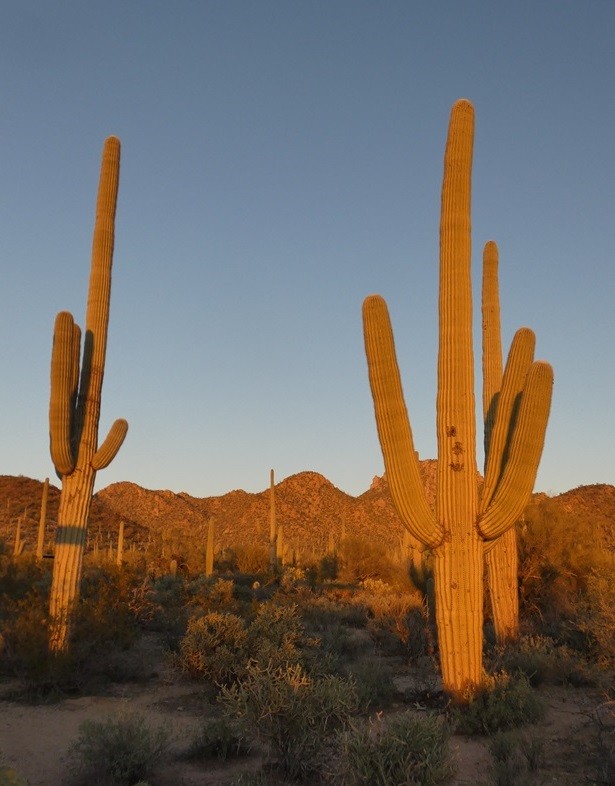
It has been a month since our last post and plenty has happened during that time. But that makes it hard to find time to write the blog, so this is just a quick update to show that we are still going strong, and our climate has changed a bit. More details of our excellent stays in Seattle, Olympia (WA), San Jose, Jackson, Morro Bay (CA), Willcox (AZ), and now Glenwood (NM) will follow eventually.
In addition to seeing many family members and friends, we have enjoyed spectacular scenery from snow-capped mountains to the Pacific Ocean to the Sonoran Desert. We have also experienced the gamut of weather conditions from the snow in Vancouver, to atmospheric rivers dumping rain on California, to frost melting to midday warmth in the desert. We will stay here in New Mexico for a couple more nights then head further east to Vicksburg, MS, and Fairhope, AL, before returning to Florida in about a week’s time. We truly appreciate the generous hospitality of all of our hosts and hope that we added something enjoyable to their winter.
In addition to seeing many family members and friends, we have enjoyed spectacular scenery from snow-capped mountains to the Pacific Ocean to the Sonoran Desert. We have also experienced the gamut of weather conditions from the snow in Vancouver, to atmospheric rivers dumping rain on California, to frost melting to midday warmth in the desert. We will stay here in New Mexico for a couple more nights then head further east to Vicksburg, MS, and Fairhope, AL, before returning to Florida in about a week’s time. We truly appreciate the generous hospitality of all of our hosts and hope that we added something enjoyable to their winter.
| Vessel Name: | Tregoning |
| Vessel Make/Model: | Morgan Classic 41 |
| Hailing Port: | Gainesville, FL |
| Crew: | Alison and Randall |
| About: | We cast-off from Fernandina Beach in north Florida on 1st June 2008 and we have been cruising on Tregoning ever since. Before buying Tregoning, both of us had been sailing on smaller boats for many years and had worked around boats and water throughout our careers. |
| Extra: | “Tregoning” (rhymes with “belonging”) and is a Cornish word (meaning “homestead of Cohnan” or “farm by the ash trees”) and was Alison's mother’s middle name. Cornwall is in southwest England and is where Alison grew-up. |
Tregoning's Photos - New Zealand and USA 2018
Tregoning

Who: Alison and Randall
Port: Gainesville, FL



















